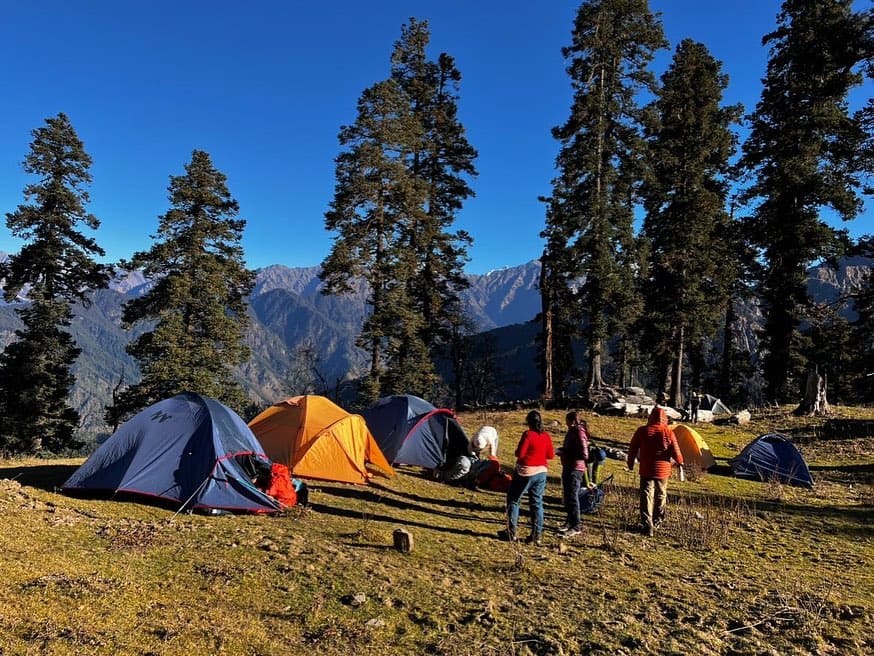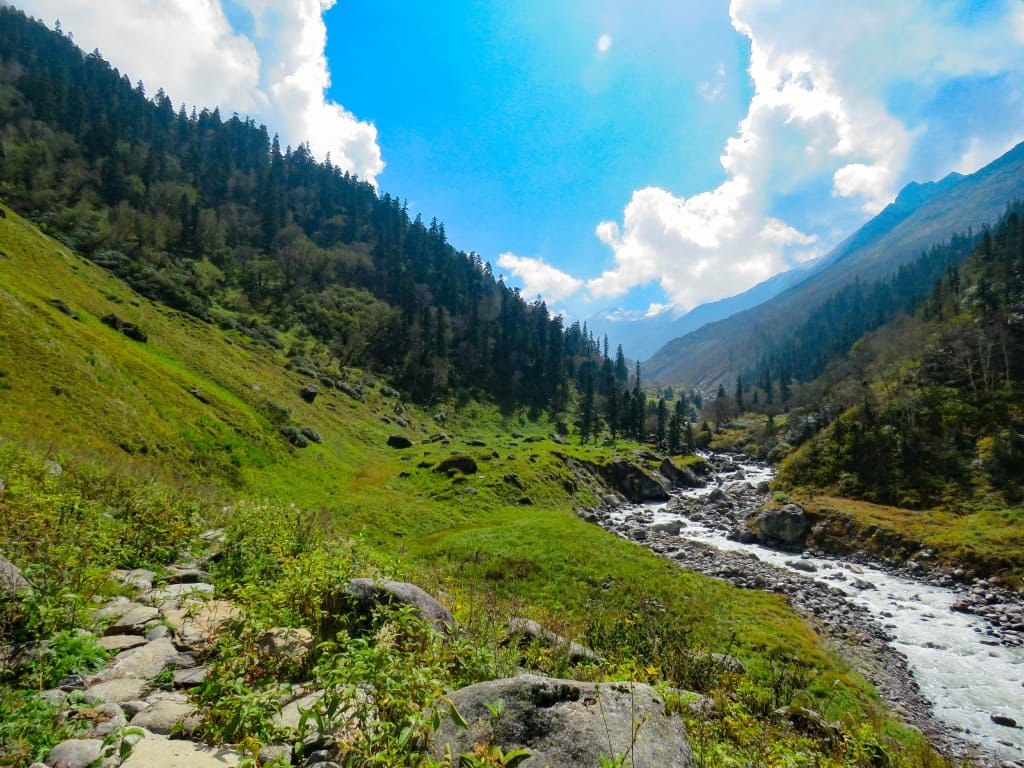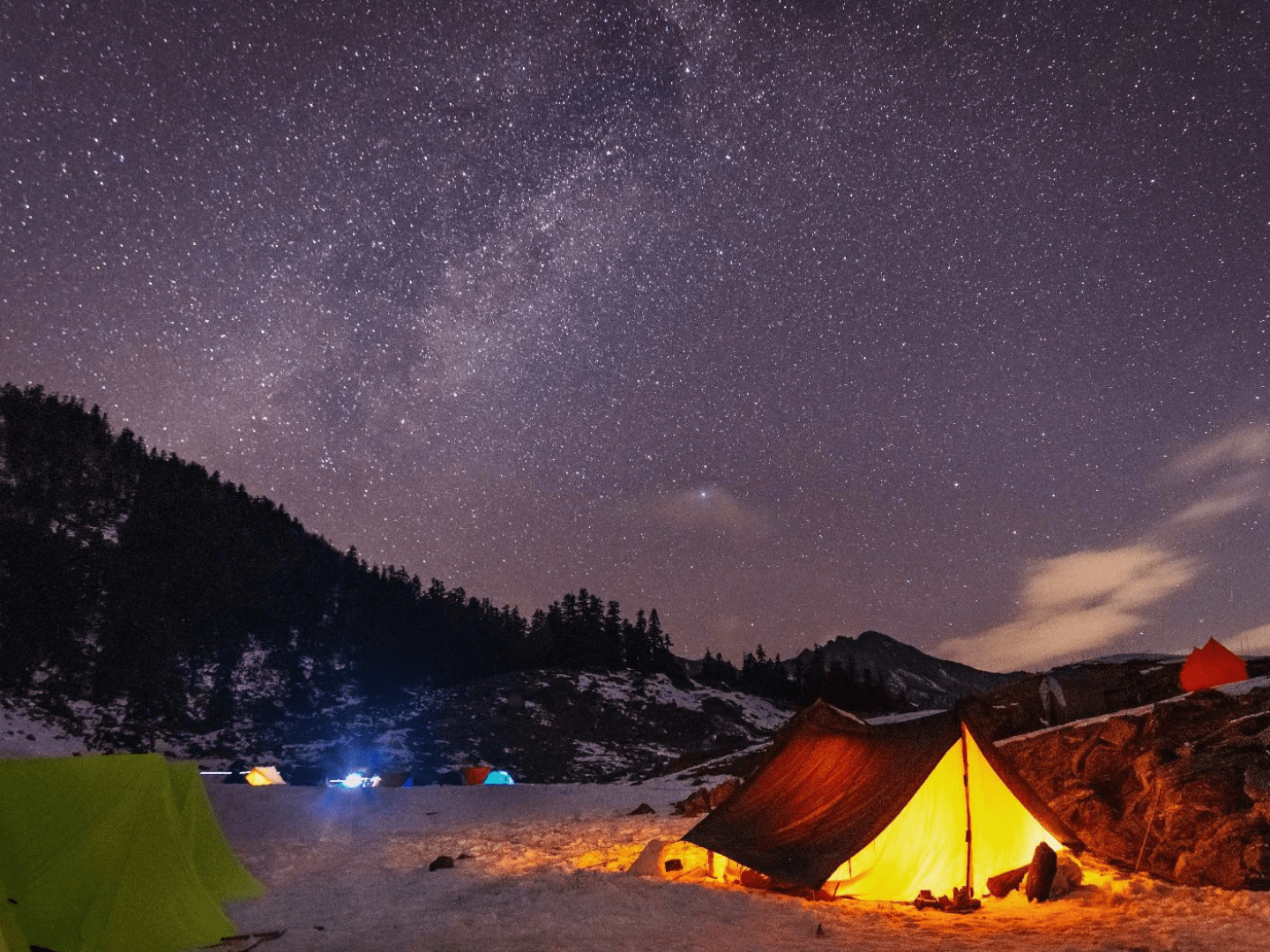Kedarkantha Trek
Kedarkantha Trek
₹ 5,499 /person | 5D - 4N | Dehradun to Dehradun
₹ 5,499/PP
5D - 4N | Dehradun to Dehradun
- Pickup Time : 7:30 To 8:00 AM
- Dropping Time : 7:30 To 8:00 PM
- Pickup & Drop Location : Dehradun Railway Station
- Inclusion & Exclusion
- Food provided by Indian Treks
Need Help Talk to our Mountain Expert
- +91- 7310954451 | +91-7300900108
BE UPDATED FOR THRILLING EXPERIENCES!
Follow Us On
➩ Description
- Altitude : 12500 ft.
- Duration: 5 Days
- Trek Length: 20km
- Base Camp: Sankri
- Trek Difficulty : Easy to Mod.
A Majestic Winter Wonderland in the Himalayas
At 12,500 ft, Kedarkantha Trek is one of the most loved winter summits in India. Starting from Sankri village, the trail takes you through pine forests, frozen Juda Ka Talab, and ends at a 360° summit view of Swargarohini, Black Peak, and Gangotri ranges. Nestled in the Govind Wildlife Sanctuary of Uttarakhand, this trek is a dream for those who wish to experience the magic of the Himalayas in winter. Often crowned as the “Queen of Winter Treks,” Kedarkantha is renowned for its accessibility, stunning landscapes, and soul-stirring summit views, making it an ideal choice for beginners and seasoned trekkers alike.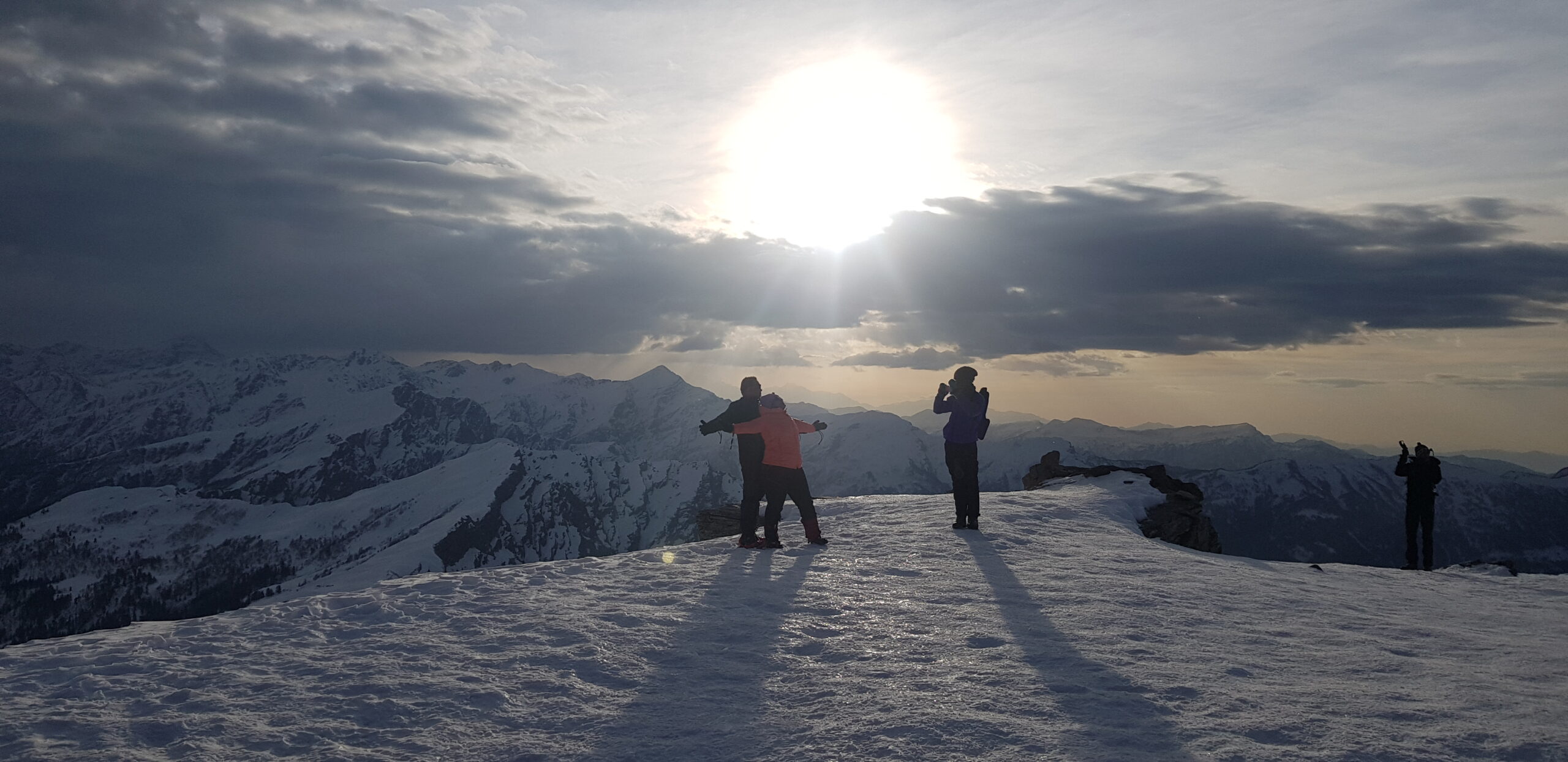
Read More
It’s little wonder that the Kedarkntha Trek is referred to be the “queen of winter treks.“ The best time to visit the Kedarkantha is definitely winter. December through April is the most beautiful time of year to visit Kedarkantha Peak Trek if you want to do snow trekking and see the place at its most beautiful. The region transforms into a winter a paradise in the winter, with the Juda ka Talab frozen and the trails having a light layer of snow. The summit ascent is an exhilarating task. The location experiences bright daytime temperatures during the winter, while chilly, icy evenings are typical. Fresh snow has blanketed the neighboring rhododendron, maple, cedar, and oak trees, making it a captivating sight. In the winter, Kedarkantha trek has a stunning scenery with clear the heavens, bright sunshine, and snow-covered towering mountains like Swargarohini, Bandarpoonch, and Black Peak. Read More: Trusted by trekkers, crafted by locals – Kedarkantha guide Another serene experience is camping at the Kedarkantha base in the winter, when you can see the unobstructed, stars sky. Trekkers in particular love this location for camping, not just for the beautiful surroundings but also for the sense of seclusion and tranquility it offers. Additionally, for those who like warm weather for trekking, the spring months of March and April are perfect. Throughout these months, Kedarkantha’s scenery is changing, and you can see the forest pathways waking up with the first signs of fresh vegetation. In the spring, Juda ka Talab is an incredible place to see. The early light glistens off the slightly frozen surface, reflecting the sky and the surrounding deep trees in a mirror-like effect. Read More: Kedarkantha Trek Best Time Sankari: A quiet, calm village in Uttarakhand’s Uttarkashi district, Sankari serves as the initial base camp for the Kedarkantha Trek. The town is the beginning point of multiple additional treks, including Har ki Dun, Phullara Ridge, Bali Pass, and others. It features traditional wooden and local dwellings and a welcoming local atmosphere. Bonfire gatherings, storytelling sessions, and warm meals served in the icy wilderness make these moments unforgettable. Trekkers often find themselves lost in the beauty of the Milky Way, capturing astrophotography shots that immortalize their Himalayan adventure. Kedarkantha Base: With its gorgeous and tranquil surroundings, Kedarkantha Base is one of the most popular destinations for trekkers. This is where you will camp on the third day of your hike. Because the foundation is in an open space, you may enjoy the mind-pleasing fresh air. The Kedarkantha base is an ideal spot for stargazing since it is a large, clean space with no artificial lighting, making it possible to view the stars clearly and brightly. Kedarkantha Peak: The main attraction of the journey is the 12,500-foot-high Kedarkantha Peak. You will be rewarded with views of stunning Himalayan peaks as you ascend the trek. Small temples of Lord Shiva, Goddess Parvati, and Lord Ganesha may be seen atop the mountain. The views that await you upon reaching the summit will make the trek enjoyable. From the peak, you can also see the dawn. It is spectacular; the sky is crimson and orange, gradually illuminating the snow-capped mountains with a warm, ethereal glow. Hargaon Base: The campsite is very gorgeous; it has alpine trees surrounding it, and you can see the mountains in the distance. You can see snow-capped peaks throughout the winter, and the camping ground is also covered with snow. The vistas are fantastic when you get up in the morning. A gorgeous panorama of some of the most renowned Himalayan peaks, including Swargarohini Peak, Bandarpoonch, Draupadi ka Danda 2, and Black Peak, awaits you after you reach the summit. Additionally, you may enjoy a stunning view of Har Ki Dun and Rupin Valleys. From the summit, the morning views are amazing. The greatest sunsets may be viewed at Kedarkantha Winter Trek, which is located on the western slope of the Garhwal Himalayas. The sky becomes orange and crimson during the golden time, and the scenery becomes quite spectacular when it reflects off the snow. The calm, scenery, and adventure of the Kedarkantha journey make it a wonderful destination for a quick weekend. Because it strikes the perfect balance between accessibility and adventure, Kedarkantha stands out as the Best Winter Trek for beginners. With its steady elevation and clearly designated routes, the trek is an excellent opportunity to get started with winter trekking without being extremely difficult. It is a quick and easy walk that typically requires only 4-5 days to complete, which is plenty to keep beginners interested and motivated. With snow-covered paths and expansive vistas of the Himalayan peaks, the gorgeous winter scenery adds a mystical element that is both motivating and attainable. The infrastructure of the walk, which includes well-established campsites and knowledgeable local guides, guarantees safety and assistance, making the experience even better for first-time trekkers. Furthermore, the courteous greetings, customs of the mountain, and and kind residents offer a warm welcoming environment. For those who are new to trekking, it is an excellent location to start.Why is Kedarkantha titled as the “Queen of Winter Treks”?
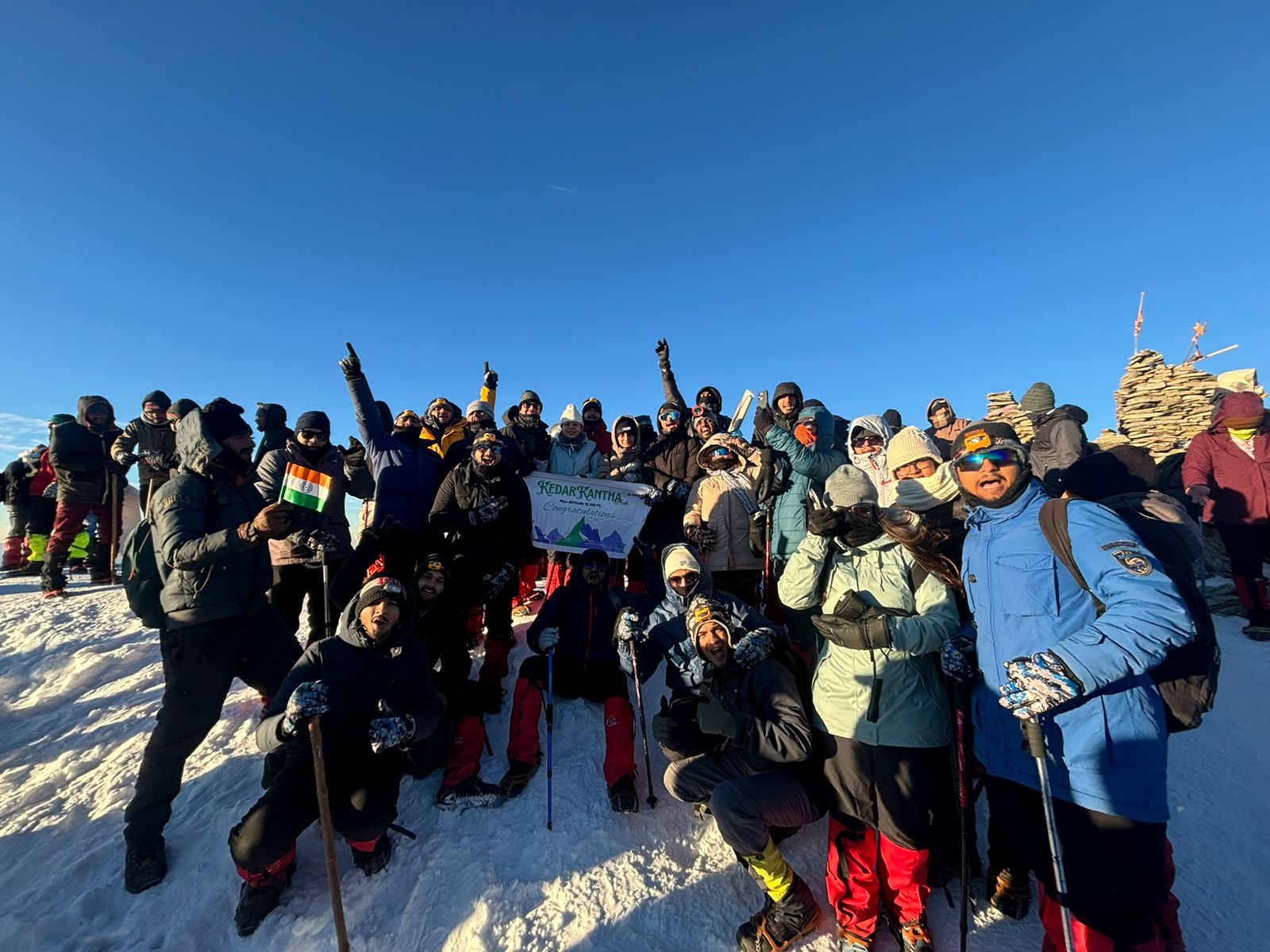
Key Points of Attraction for the Kedarkantha Trek
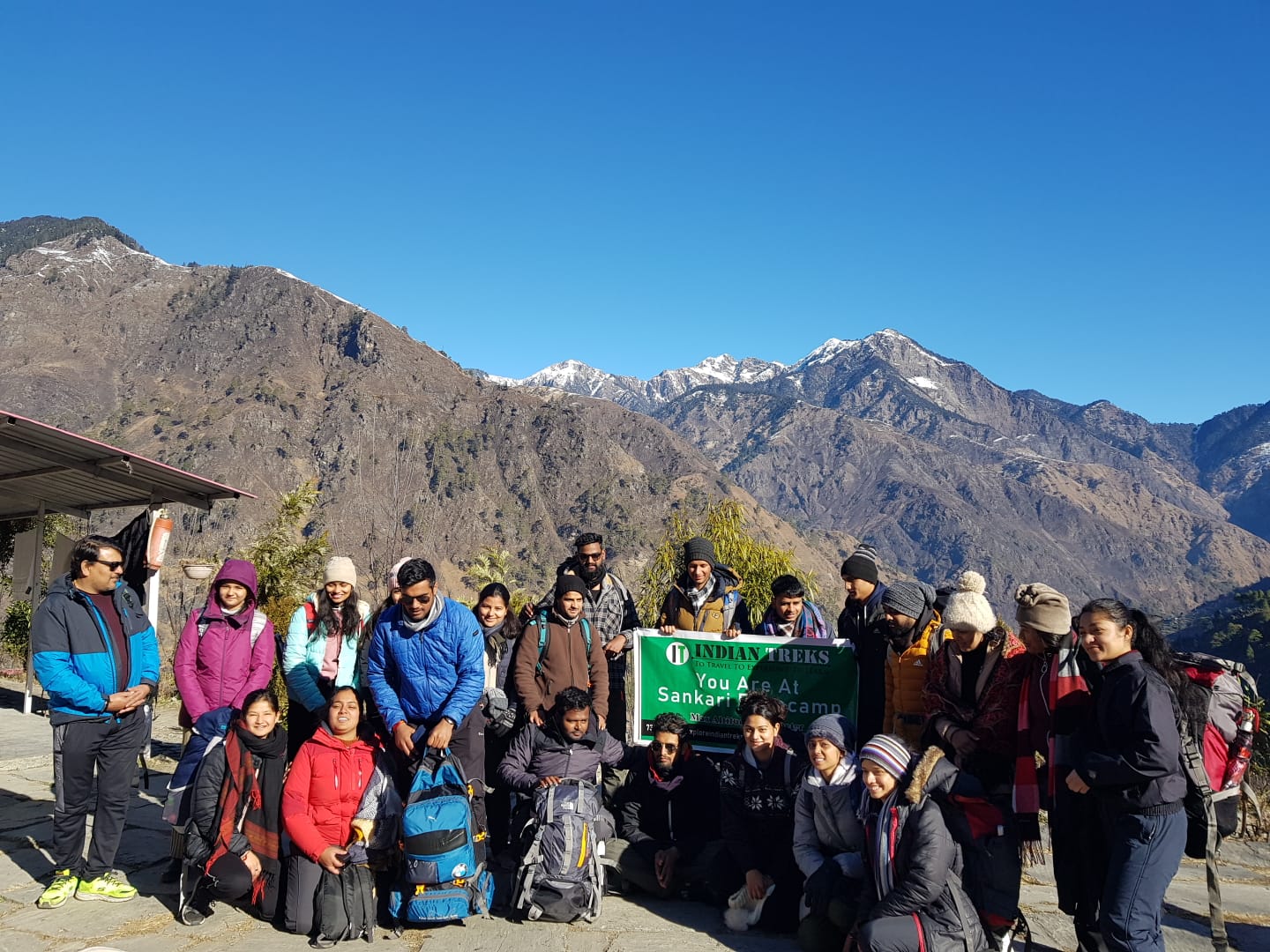 Camping Under a Starlit Canopy: Each day on the Kedarkantha trek is a blend of adventure and serenity, but the nights are nothing short of magical. The campsites—Juda Ka Talab, Kedarkantha Base, and Hargaon—are strategically chosen for their scenic beauty. Imagine camping beside a partially frozen alpine lake, surrounded by towering pine trees under a sky brimming with countless stars. The silence of the mountains, interrupted only by the soft whisper of the wind, creates an atmosphere of unmatched peace.
Camping Under a Starlit Canopy: Each day on the Kedarkantha trek is a blend of adventure and serenity, but the nights are nothing short of magical. The campsites—Juda Ka Talab, Kedarkantha Base, and Hargaon—are strategically chosen for their scenic beauty. Imagine camping beside a partially frozen alpine lake, surrounded by towering pine trees under a sky brimming with countless stars. The silence of the mountains, interrupted only by the soft whisper of the wind, creates an atmosphere of unmatched peace.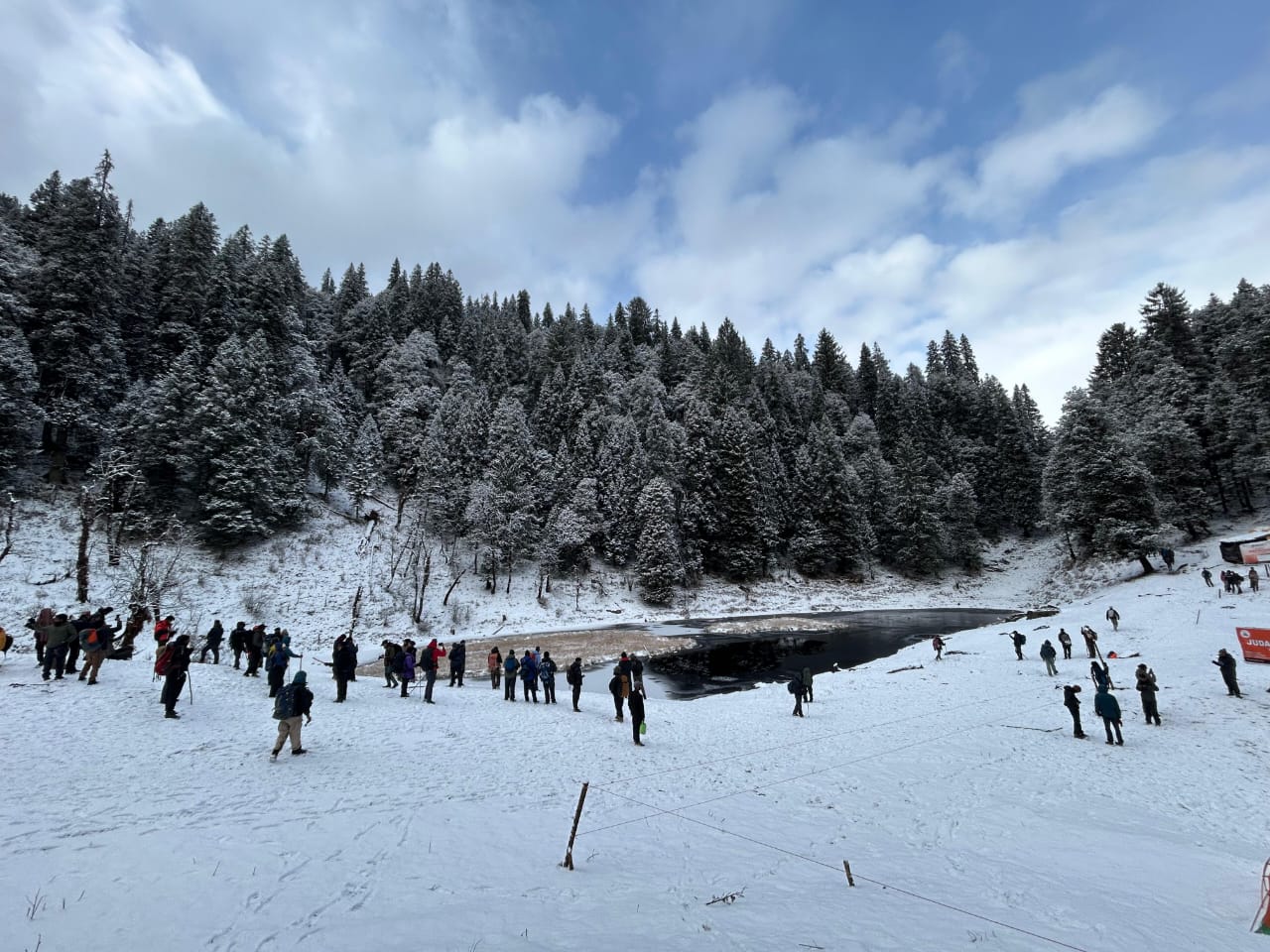
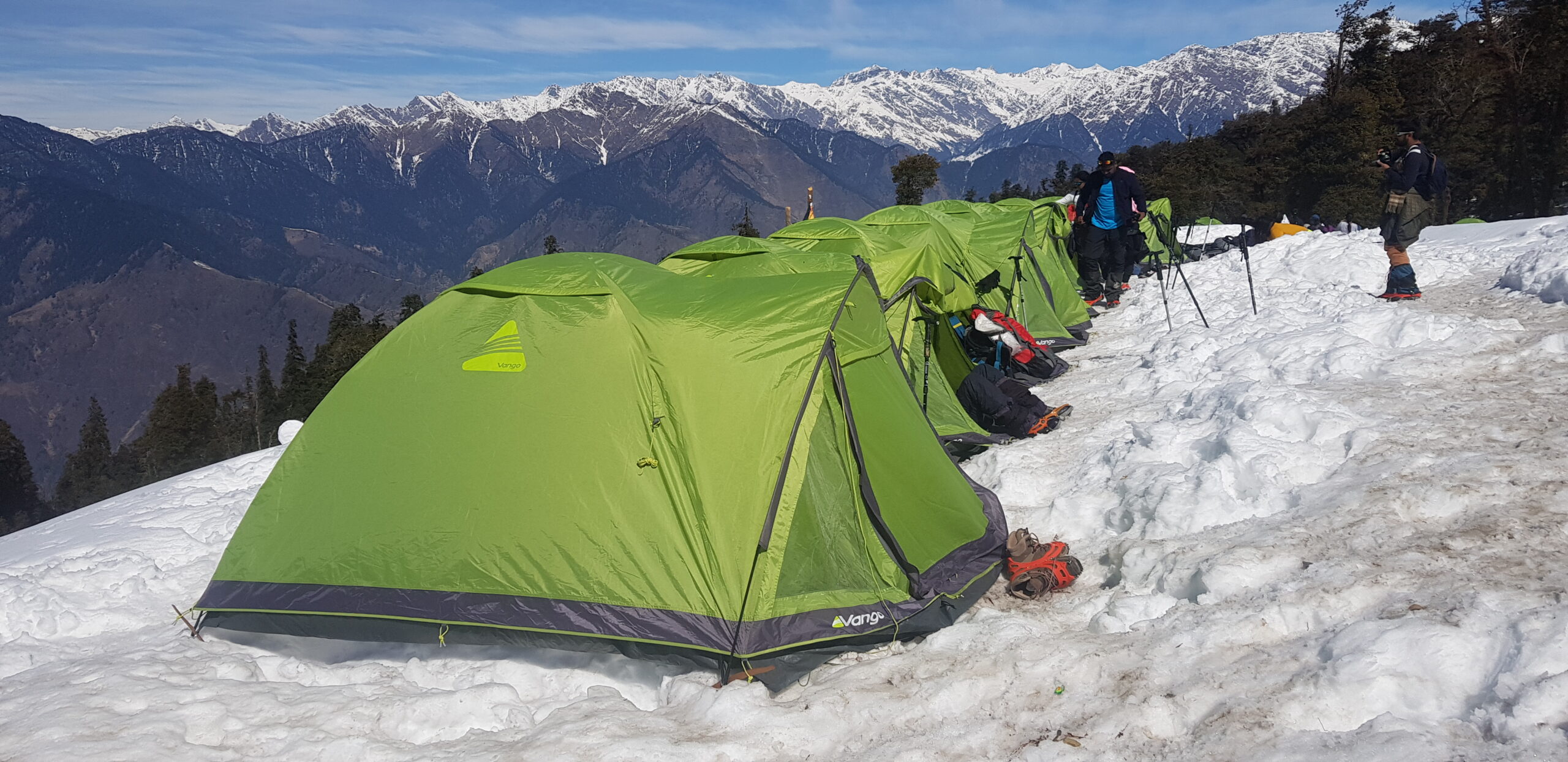
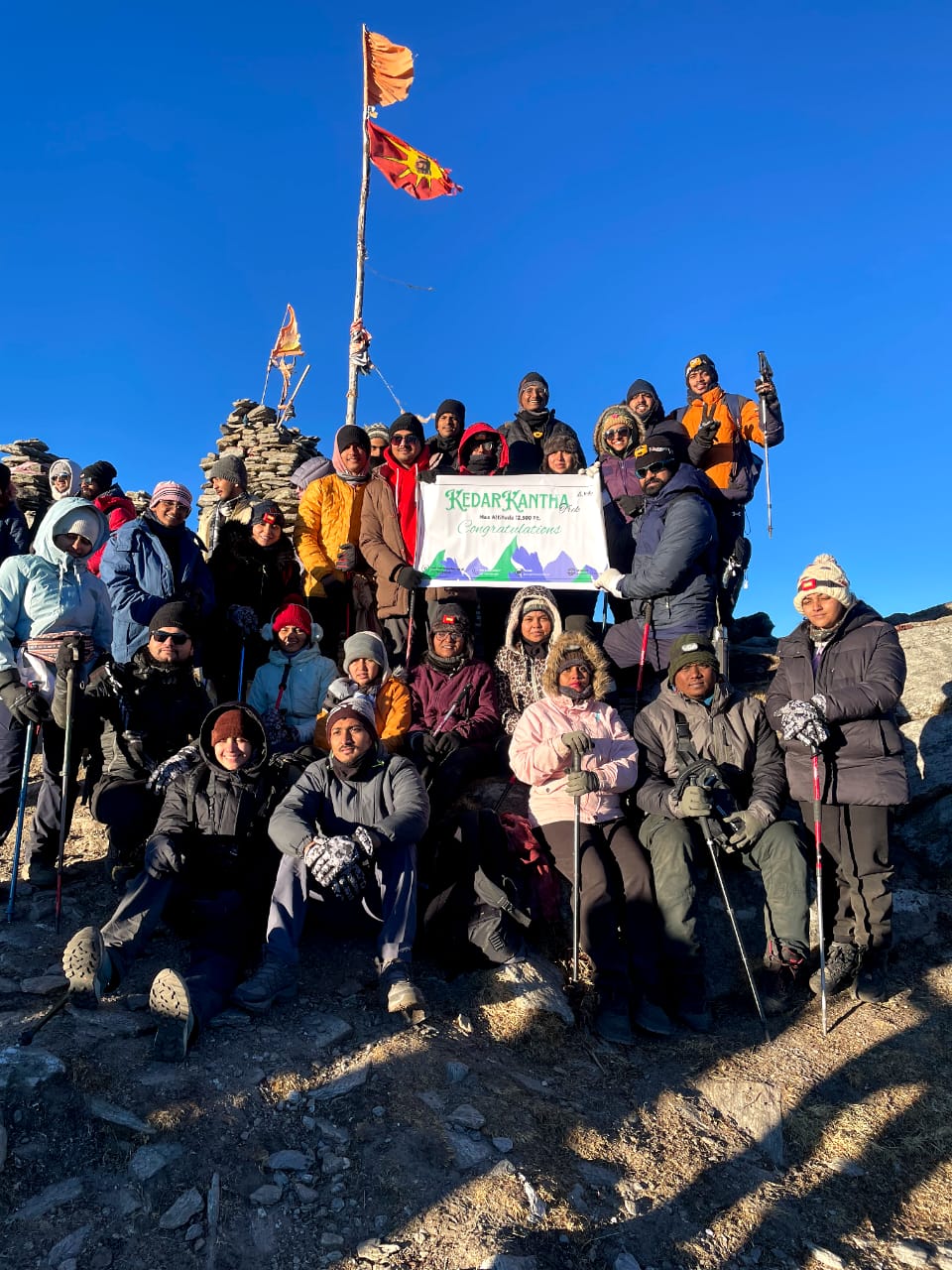
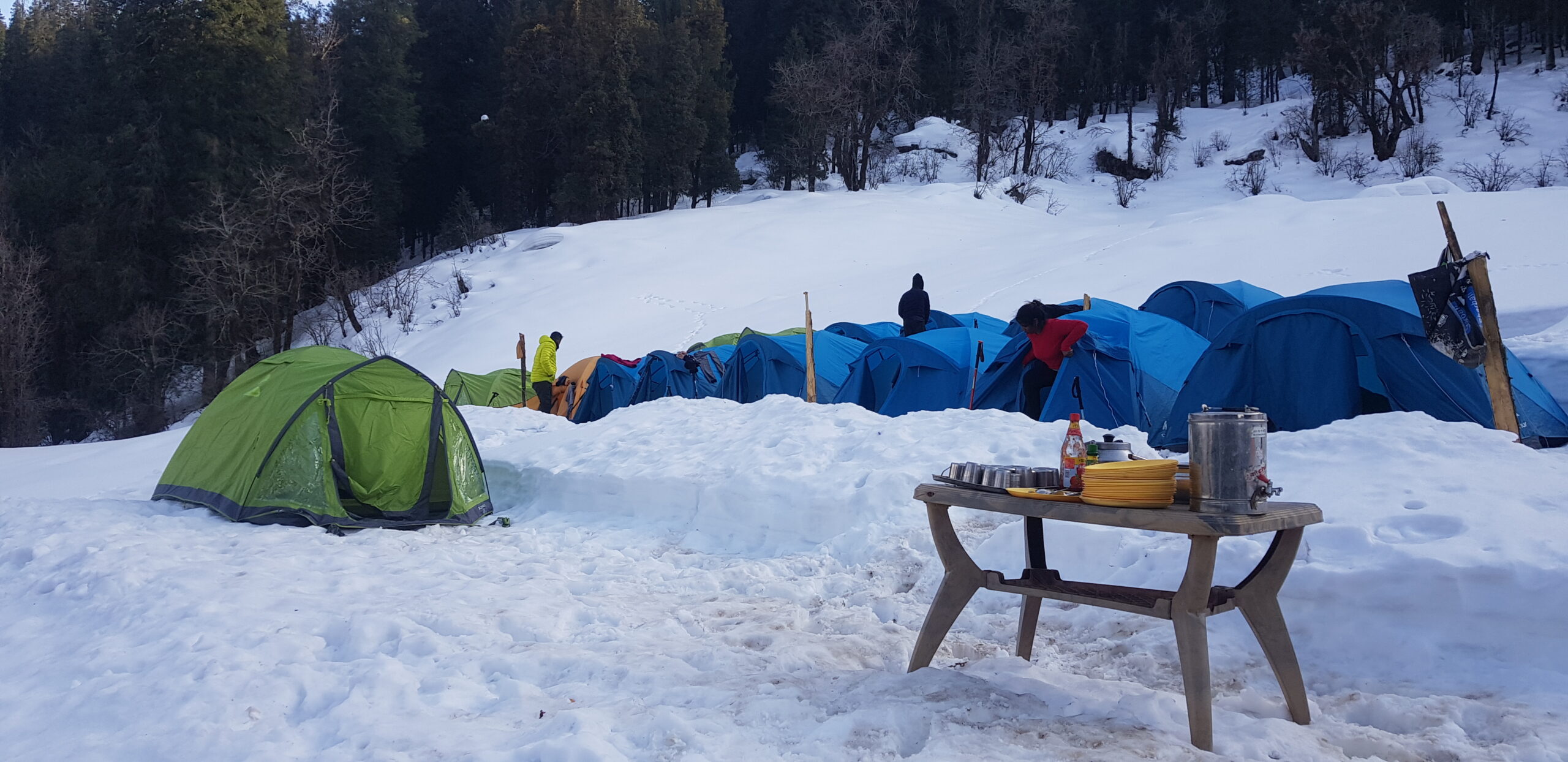
Kedarkantha Peak’s Mountain Panorama
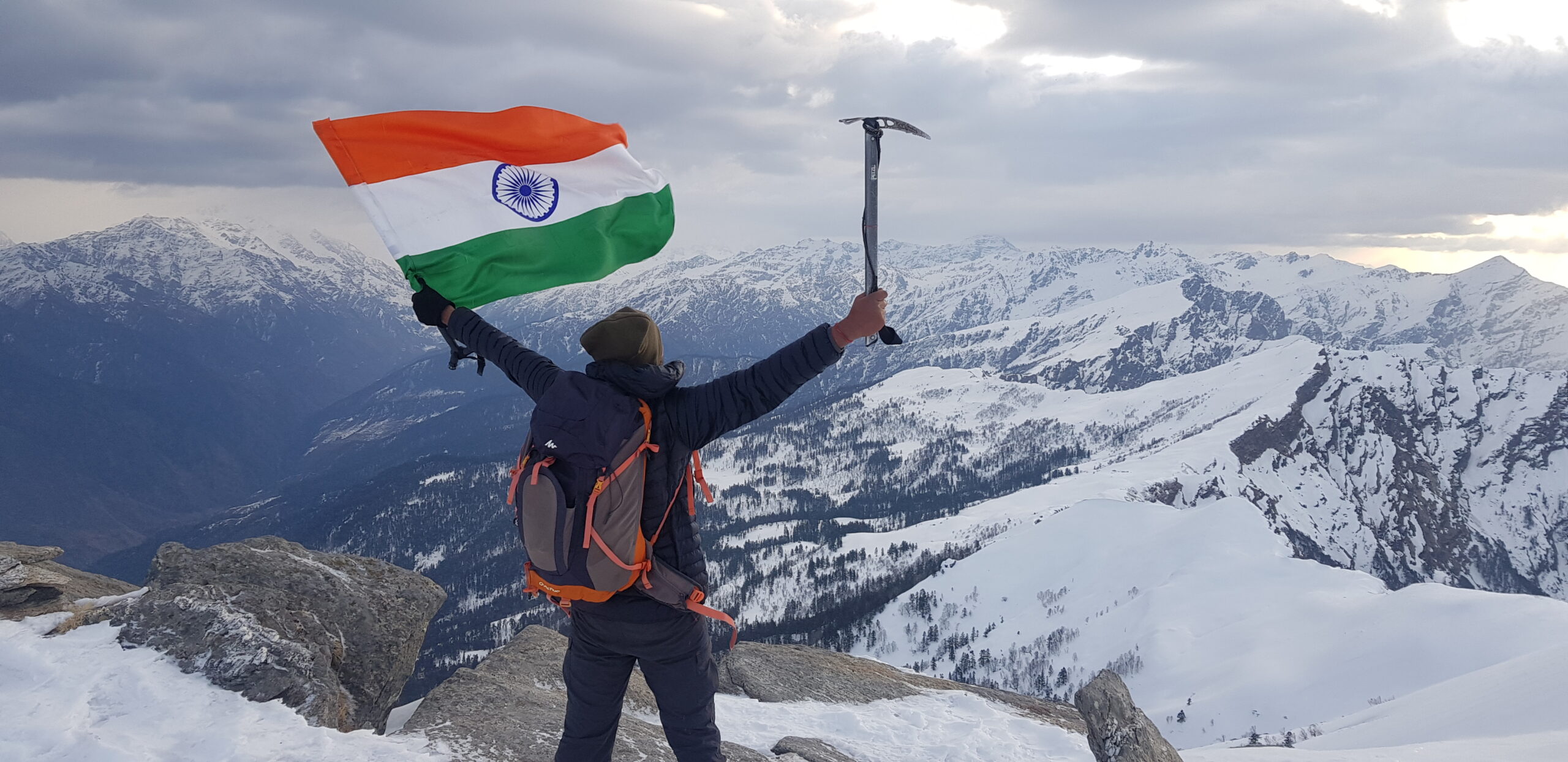
Perfect Trek for Beginners / Best Choice for Beginners
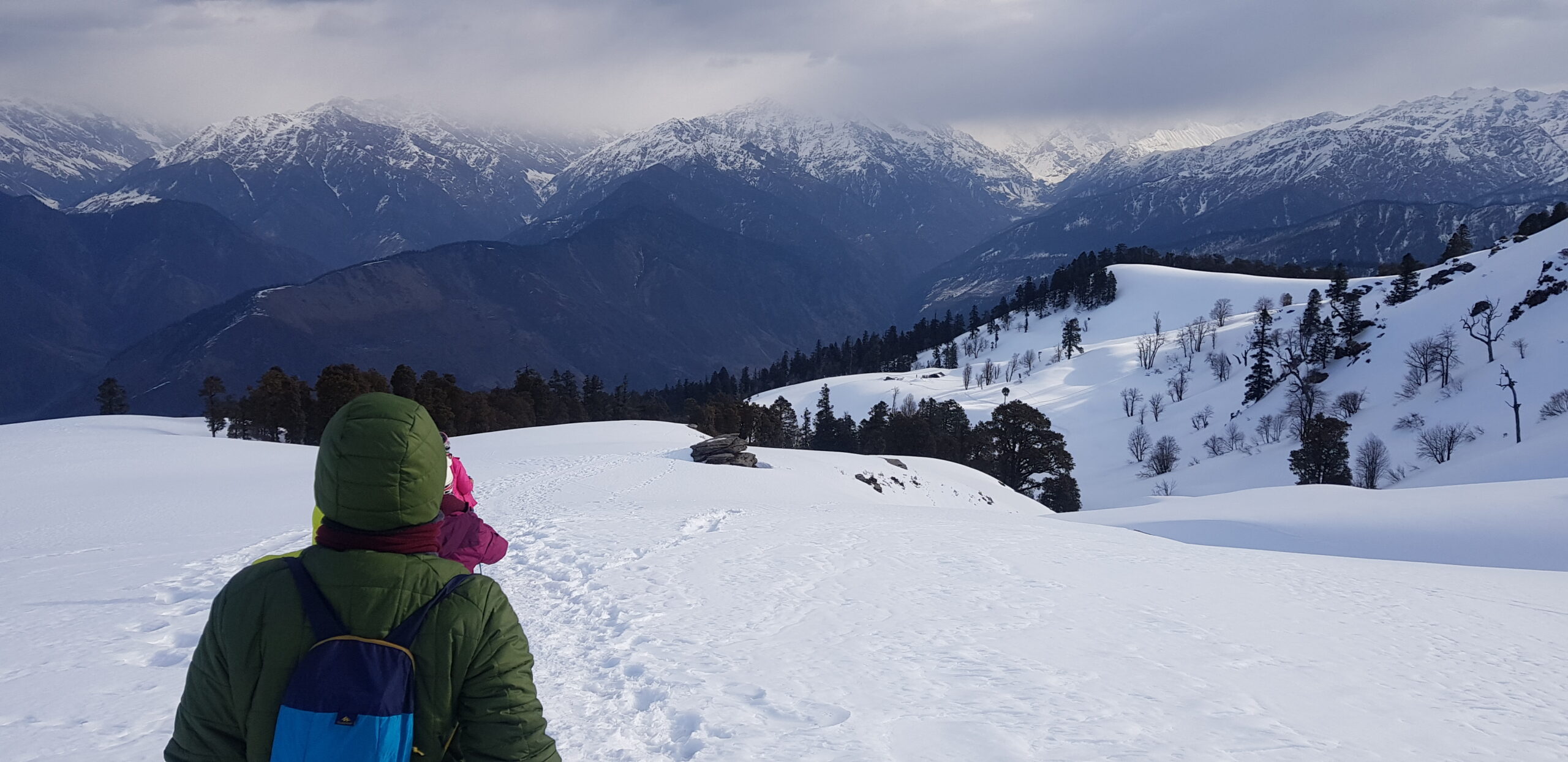
➩ Itinerary
Total distance: 190 km, 8 or 9 hours; mode of transportation: Tempo Travellers; elevation: Sankri Base Camp, 1920 meters; and overnight accommodations: Our Hotels.
Indianreks organizes transport for trekkers from Dehradun Railway Station in the morning which will leave for Sankri around 6:00 am to 7:00 am.
Uttarakhand's capital, Dehradun, is one of India's most beautiful places. Rajpur Road is the area's main attraction; drive along to get a sense of Dehradun's beauty. After an hour, arrive in Mussoorie, also referred to as the "Queen of Hills." When on vacation with friends and family, a lot of people visit there.
Dehradun to Sankri – A Journey Through the Himalayas
The road to Sankri, the base camp for many famous Himalayan treks, is a journey in itself. Starting from Dehradun, the drive takes you through winding mountain roads, lush valleys, charming villages, and dense forests, giving you a taste of Himalayan beauty before you even begin trekking.
Dehradun to Mussoorie: The adventure often begins in Dehradun, heading towards the picturesque hill station of Mussoorie. Surrounded by misty hills, pine forests, and cool breezes, Mussoorie sets the tone for the scenic drive ahead.
Mussoorie to Kempty Falls: A short detour brings you to the famous Kempty Falls, a refreshing stopover where cascading water tumbles down amidst green hills. It’s a popular spot to stretch your legs and enjoy the fresh mountain air.
Purola: As you continue, the road winds through Purola, where the landscape starts to change. The terrain becomes more rugged and hilly, giving glimpses of traditional Himalayan villages and terraced fields.
Charming Villages & Forests: The route is dotted with small hamlets and farmlands. Terraced fields, apple orchards, and wooden houses showcase the simple yet beautiful lifestyle of the mountain people. Pine and deodar forests line the roads, adding freshness to the journey.
The Valleys & Tons River: Approaching Sankri, you enter the breathtaking Tons River Valley. The turquoise river flows gracefully between lush green mountains, offering postcard-perfect views that make the drive unforgettable.
The Final Stretch: The last leg of the journey takes you through dense forests and narrow mountain roads. Though the drive can be adventurous, the unfolding vistas of snow-capped peaks make every turn worth it.
Arrival at Sankri: Finally, you reach Sankri (6,400 ft), a serene village nestled in the Western Garhwal Himalayas. With stunning views of Swargarohini peaks, vibrant sunsets, and starry skies, Sankri welcomes you warmly before the start of your trek.
Check in at the hotel, freshen up, and enjoy evening snacks with mountain views. After a short trek briefing and an optional village walk, return for dinner and an overnight stay in Sankri.
Trek Distance: 5 km; Duration: 4/5 hours Trek | Travel method: foot | Elevation: Juda ka Talab, 2700 meters | Accommodation: shared camp in tents
Today, a warm morning awaits you. Feel the peace in the mountains; there is no connectivity or materialistic thing to disturb you; all that exists is peace.
Enjoy a nice cup of coffee or tea at 6:00 a.m. and ready for breakfast at 7:30 a.m. You must leave at 8:30 a.m., following your guide's instructions.
The trek from Sankri to Juda Ka Talab on the way to Kedarkantha is an enjoyable trek through the lush forests of Uttarakhand's Govind National Park. Here's a rough route and some of the picturesque highlights along the way:
Sankri (Base Camp): Your trek to Kedarkantha begins from the quaint village of Sankri (6,400 ft). Surrounded by snow-clad peaks, apple orchards, and lush meadows, Sankri is a picture-perfect Himalayan hamlet that sets the tone for the journey ahead.
Forest Trail: As you leave Sankri, the trail leads into dense forests of pine, oak, and rhododendron. The walk is refreshing, with the fragrance of pine in the air and chirping birds accompanying you. During springtime, the blooming rhododendrons add splashes of red and pink, making the forest come alive.
Scenic Views Along the Way: Every now and then, the trees open up to reveal glimpses of mighty Himalayan peaks. On clear days, you can spot the Swargarohini range, Bandarpoonch, and Black Peak in the distance — each view more rewarding than the last.
Water Crossings: The route is sprinkled with small streams and natural water crossings. These make for refreshing halts, allowing trekkers to refill bottles, relax, and soak in the serenity of the surroundings.
Kedarkantha Base Camp: After a steady climb of a few hours, you arrive at the Kedarkantha Base Camp, a wide-open meadow nestled at the foot of the peak. The campsite offers breathtaking panoramic views of the surrounding mountains, especially during sunset when the sky turns golden and the peaks glow in soft hues.
Juda Ka Talab: The trail from base camp continues through forests and meadows until you reach Juda Ka Talab, one of the most scenic campsites of the trek. This small alpine lake is surrounded by pine trees and open grasslands. In winter, it often freezes over, while in summer, its clear waters beautifully reflect the surrounding peaks. With Kedarkantha Peak standing tall in the backdrop, this campsite offers a truly magical experience.
Mountain Views: From Juda Ka Talab, the view of Kedarkantha Peak feels much closer, making the excitement of the summit stronger. The crisp mountain air, starlit skies at night, and the peaceful atmosphere create the perfect Himalayan camping experience.
The trek from Sankri to Juda Ka Talab is admired for its natural beauty and moderate difficulty, making it an ideal choice for both beginners and seasoned trekkers. The trail passes through dense forests, open meadows, and occasional clearings that offer glimpses of snow-capped peaks.
While the route is popular, it is always advisable to trek with a guide or in a group. Mountain weather can change quickly, and having an experienced local guide ensures both safety and a richer experience. A guide can share valuable insights about the flora, fauna, and culture of the region while also helping you navigate the trail with ease.
Trek Distance - 03 Km - 2/3 Hours Trek | Mode of Travel - on foot | Altitude - Kedarkantha Basecamp - 3200 Meters | Night Stay - Camp in a tent- on twin share basis
The trek from Juda Ka Talab to Kedarkantha Base Camp is a crucial part of the Kedarkantha trek in Uttarakhand, India. It offers amazing views of the Himalayan landscape. The following is a provide of the route and what you may expect to see along the way.
Juda Ka Talab: Your journey begins from Juda Ka Talab (9,000 ft), a stunning alpine lake surrounded by meadows and tall pine forests. The clear, still waters of the lake often mirror the surrounding peaks, creating a picture-perfect and peaceful setting. Before moving ahead, take a moment to enjoy the quiet beauty of this unique campsite.
Gradual Ascent: From Juda Ka Talab, the trail to Kedarkantha Base Camp involves a steady but gradual ascent. The path winds through open meadows and thick forests, and in winter, it’s often blanketed with fresh snow. Proper footwear and trekking poles are essential here for balance and safety.
Views of Kedarkantha Peak: As you gain altitude, Kedarkantha Peak itself begins to appear more frequently on the horizon. Its snow-clad summit becomes an inspiring sight and a constant reminder of the goal ahead.
Pine Forests & Meadows: The trail alternates between dense pine forests and vast meadows. In snowy conditions, the forests look enchanting — with tall, snow-dusted trees lining the trail like a fairytale setting.
Mountain Vistas: Throughout the trek, the views keep opening up to reveal spectacular Himalayan ranges. On clear days, you can spot the Swargarohini peaks, Bandarpoonch, Black Peak, and the Gangotri–Yamunotri ranges. These vistas grow even more captivating as you climb higher.
Kedarkantha Base Camp: After a few hours of trekking, you reach the Kedarkantha Base Camp (11,250 ft). This wide meadow is surrounded by towering peaks and offers 360-degree Himalayan views. The peak itself stands prominently in front of you, making this an ideal spot to rest, acclimatize, and prepare for the final summit push.
Snow in Winter: If you are trekking in winter, the trail and campsite are often covered in snow, turning the base camp into a magical white wonderland. While it adds a layer of challenge, it also enhances the beauty and thrill of the experience.
The Kedarkantha Base Camp is a favorite overnight halt for trekkers before the final summit push. Nestled in a wide meadow with stunning views of surrounding peaks, it offers the perfect setting to rest and acclimatize. The crisp mountain air, starlit skies, and the calm, quiet atmosphere make it an ideal place to recharge your energy and prepare for the exciting summit climb the next morning.
Trek Distance: 11 kilometers - 7/8 hours. Trek | Mode of travel - On foot | Altitude - Hargaon thach - 2645 meters | Night Stay - Camp in a tent on a twin-sharing basis
Summit Day: Today is the highlight of your trek. Wake up early around 3:30 am and begin your climb to the Kedarkantha summit. The trail is steep but rewarding, and reaching the top just in time for sunrise is an unforgettable experience. As the first rays of the sun light up the snow-covered peaks, the 360° Himalayan panorama leaves every trekker spellbound. Watching the golden sunrise from the summit is a moment that stays with you forever.
The Kedarkantha Summit is the final destination of the trek, offering breathtaking 360° views of the surrounding Himalayan ranges. The route from Kedarkantha Base Camp to the summit involves a steady ascent through meadows and snowy ridges, gradually leading to the steep final climb. Once at the top, trekkers are rewarded with a panoramic sight of majestic peaks like Swargarohini, Bandarpoonch, Black Peak, and the Gangotri–Yamunotri ranges, making it the most memorable moment of the entire journey.
Starting from Kedarkantha Base Camp: The final ascent to the Kedarkantha summit begins from the high-altitude meadow of Kedarkantha Base Camp (11,250 ft). This campsite is the launching point for the most awaited part of the trek.
Early Start: To witness the magical sunrise, trekkers usually begin the climb well before dawn (around 3:00–3:30 am). Starting early also ensures firmer snow underfoot and clearer skies.
Ascent through Alpine Meadows: The initial section of the trail is a gradual climb across wide alpine meadows. As you move higher, the terrain opens up and the path alternates between rocky patches and stretches of snow.
Snow-Clad Terrain (in Winter): During winter, the route remains blanketed in thick snow, making the ascent both challenging and enchanting. Trekking poles and proper footwear are especially important here for stability.
Expansive Mountain Views: With every step higher, the horizon expands. Soon, majestic Himalayan peaks such as Swargarohini, Bandarpoonch, Kalanag (Black Peak), and parts of the Gangotri–Yamunotri ranges reveal themselves. The closer you get to the summit, the more awe-inspiring the views become.
Kedarkantha Summit (12,500 ft): Finally, after a few hours of climbing, you stand atop the snow-clad Kedarkantha summit. From here, a 360° panorama of the Garhwal Himalayas unfolds before you. On one side lies the grandeur of the Swargarohini and Bandarpoonch ranges, while on the other, the Har Ki Dun Valley stretches out beautifully below. The shrine at the summit and the golden glow of sunrise together make this the most unforgettable moment of the trek.
The Kedarkantha summit, standing tall at around 12,500 ft (3,800 m), is famed for its breathtaking 360° panoramic views of the Himalayas and valleys below. It is one of the most cherished spots for trekkers, especially at sunrise, when the first rays of the sun paint the snow-clad peaks in shades of golden and orange, creating an unforgettable spectacle.
Trek Distance: 4.5 km - 2/3 hours Trek (190 km drive from Sankri to Dehradun) | Mode of travel - By Tempo Travellers or on foot
This morning, enjoy a hearty breakfast at your final campsite of the trek. After packing up, begin your descent from Hargaon to Sankri. The trail is easier downhill and takes you through beautiful forest clearings and scenic viewpoints. As you get closer to Sankri, you’ll pass by charming apple orchards before finally reaching the village, marking the end of your unforgettable Kedarkantha journey.
Hargaon Campsite: Your final day of trekking begins at Hargaon (8,500 ft), a peaceful campsite nestled in dense forests. The quiet surroundings, chirping birds, and rustling leaves create a soothing farewell to the mountains.
Descend through Forests: The trail from Hargaon to Sankri is mostly a descent through thick pine and oak forests. Unlike the alpine meadows higher up, this section offers a different charm, with tall trees lining the path and cool shade throughout.
Mountain Views: Even on the way down, you’ll catch occasional glimpses of the snow-covered Himalayan peaks through openings in the forest. The play of sunlight and shadow filtering through the trees adds to the beauty of this stretch.
Passing Through Villages: As you near Sankri, the forest gradually gives way to villages and terraced fields. The simple wooden houses, apple orchards, and encounters with friendly locals provide a glimpse into the traditional lifestyle of the region.
Sankri – Trek Ends: Your journey concludes as you arrive back in Sankri (6,400 ft), the quaint Himalayan village where the adventure began. Surrounded by lush green landscapes and snow-clad peaks, Sankri is the perfect place to celebrate the completion of your Kedarkantha trek.
Departure from Sankri:
Today, enjoy your last breakfast with the Indiantreks team at Sankri. After a small certificate distribution ceremony and some memorable group photos, it’s time to bid farewell to the mountains.
Indiantreks will arrange transport from Sankri to Dehradun Railway Station, departing around 11:30 am. The drive takes you through the same scenic valleys and villages, with expected arrival at Dehradun between 9:00 pm – 10:00 pm.
With hearts full of memories and new friendships, your Kedarkantha trek with Indiantreks comes to a close.
➩ Trek Cost Inclusions
Accommodation (as per the itinerary
- Day 1 of the triple, quad, or penta guesthouse. (Female and male accommodations are made separately.)
- Days 2, 3, 4, and in a tent (sharing twins).
Meals (Paneer + vegetable):
- Dinner on Day 1 to Day 5 breakfast according to the schedule.
- Consuming tap or mountain water for drinking when trekking
Trek Crew:
- 1 versatile base camp manager manages communication and sends out additional staff members when necessary.
- One professional trip leader who is certified in mountaineering and first aid.
- One skilled cook at high altitudes.
- The number of experienced local guides varies according on the size of the group.
- Enough helpers.
Read More
Trek equipment: First aid:
➩ Trek Cost Exclusions
- Any meals or accommodation not specifically listed in the program or on the itinerary.
- Any bus or airfare to and from the starting point or ending of the journey
- Your medicine is covered by personal medical costs.
- Any personal services like phone calls, laundry, alcohol, mineral water, etc.
- Any fees for still or video cameras
- Any entrance fees Pay immediately at monuments, monasteries, museums, and temples.
- Private luggage is carried by mules or porters for a fee (Offload If paid online, the cost per bag is 300 per day (1,200 at base camp). Note: The maximum weight for a bag is 10 kilograms.
- Any fees associated with an emergency evacuation
- Any services not included in the section on cost inclusion.
➩Delicious & Nutritious Food During Trek
Enjoy a nutritious and delicious breakfast made by our experienced cooks to start your trekking day. Our meals are specifically created to give you the nourishment and energy needed for high-altitude trekking, so you'll be ready for the journey ahead.
In the heart of the Himalayas, savor a range of fresh, healthful, and tasty alternatives, such as light snacks, traditional Indian cuisine, and cool drinks.
At Indiantreks, we think that delicious cuisine makes trekking more enjoyable by keeping you energetic and prepared to explore the stunning mountain routes!
Beverages:
Ginger, Masala, or Regular Tea
Orange Fresh Juice with Coffee
Light Snacks & Bread:
Veg sandwiches
jam and butter
Indian breakfast Delights Include Plain:
Cheese, and Masala Omelettes
Pickle Mix and Aloo Paratha with Curd Vegetable Poha with Lemon Porridge (either semolina or oats)
The Chole Bhature
Aloo Poori (Upma Style) Mix Veg Vermicelli
To keep you energized on your trek, we provide a tasty and fresh breakfast. Savor the tastes of home-cooked meals while taking in the breathtaking Himalayan scenery!
At Indiantreks, we make sure your noon lunch is filling and tasty so you'll be strong and ready for the trek. All of the dishes on our expertly designed lunch menu are freshly made in the mountains by our experienced cooks, providing the ideal blend of tastes, nutrition, and diversity.
Enjoy a filling meal prepared with foods that are acquired locally, giving you the energy you need to tackle the terrain. We have meals that are light on the stomach and high in energy, whether you're craving a satisfying bowl of dal and rice, a protein-rich paneer dish, or a cool curd and salad.
Main Course:
Roti: freshly baked bread made with whole wheat
A Variety of Vegetables Sabzi: A wholesome combination of in-season veggies
Paneer Bhurji and Paneer Butter Masala are tasty and high in protein paneer meals.
Yellow Dal Tadka or Dal Makhni are slow-cooked lentils that are high in nutrients and flavor.
Vegetables Light and fragrant rice kinds include Pulao, Jeera Rice, and Peas Pulao.
Chole masala and Rajma masala are traditional North Indian dishes that make for a delicious lunch.
Raita (vegetable or boondi) or curd: cool and refreshing dairy sides
Enjoy the familiar tastes of home-cooked meals while taking in the stunning Himalayan scenery—because delicious food adds even more special memories to any journey!
Refresh your energy with a tasty assortment of snacks and a warm cup of tea or coffee after a strenuous day of trekking. We provide freshly made evening refreshments at Indiantreks, which are ideal for keeping you content and comfortable in the cool mountain air.
Enjoy the comfort of hot drinks and crunchy, delicious appetizers that are freshly prepared in the Himalayas. Every meal enhances the delight of your trekking trip, whether it's a plate of standard Maggi, a warm bowl of soup, or crunchy pakoras.
Beverages:
Ginger, Masala, and Regular Tea: A calming Himalayan delicacy
Coffee: A rich, fragrant way to start the day
Comforting and creamy, hot chocolate is ideal for chilly nights.
Soups: (Vegetable, Tomato, Sweet Corn Mix) It is nutritious, light, and comforting.
Foods for snacking:
Snacks: Crispy, delicious bread pakodas with green chutney
Onion, Paneer, and Spinach Veg Pakoda: Delicious deep-fried food to keep you warm
Maggi (Vegetable/Plain): The best comfort food for the mountains
French fries are served hot, crunchy, and golden.
A traditional savory dish with a burst of spice is the Samosa.
Light, crisp, and ideal for sharing is popcorn.
Because delicious food and wonderful people make every walk special, enjoy these times as you gather around the bonfire, talk stories, and enjoy the incredible sunset views!
Warm, nutritious, and filling food that has been freshly made at high altitudes is the perfect way to chill out after a strenuous day of trekking. To help you recuperate and unwind after an exciting day on the trails, we at Indiantreks make sure that every meal is not only nourishing but also cozy and tasty.
With a blend of traditional Indian tastes, healthy ingredients, and well-balanced dishes, our thoughtfully chosen supper menu offers you the ideal way to round off the day. Every meal, whether it's a filling dal with jeera rice, paneer curry, freshly made rotis, or a sweet delight, is made using ingredients that are acquired locally and freshly to keep you going the following day amazing journey.
Main Course:
Shahi Paneer or Mattar Paneer, which is flavorful, creamy, and rich.
Jeera rice with rajma is a classic and delicious North Indian dish.
Freshly prepared roti or paratha with seasonal sabzi using products from the area
Tadka Daal, also known as Yellow Daal, is flavorful, light, and high in protein.
Aloo-Gobhi/Aloo-Methi: the perfect combination of nutrition and spices
Combine Fried Rice or Noodles with Vegetable Manchurian: A Fusion Treat for Variety
Chana Daal or Masur Daal are nutritious lentils that are prepared to perfection.
Desserts & beverages:
Gulab Jamun: A delicious treat that melts in your mouth
Traditional Indian sweets that provide a sweet finish to your dinner include Sooji Halwa and Gajar Halwa.
A cozy and pleasant beverage to have before bed is Bournvita with hot milk.
Herbal Tea (Optional; aids relaxation and digestion)
Enjoy your delicious meal while conversing with other trekkers and basking in the warmth of the mountains beneath a starry sky. Because delicious cuisine is a crucial component of an amazing journey at Indiantreks!
➩ Fitness Required For Kedarkantha Trek
The Kedarkantha Trek is one of India’s most popular winter treks, known for its captivating snow-covered paths, thick pine woods, and expansive Himalayan views. Even though it’s regarded as a beginner-friendly trek, it requires a certain amount of physical stamina and fitness to enjoy and finish without experiencing too much weariness. You can guarantee a safe, joyful, and rewarding trekking trip by planning well in advance.
Read More
At altitudes of up to 12,500 feet, the Kedarkantha journey entails several hard ascents and descents. Higher elevations result in lower oxygen levels, and the problem is made worse by cold weather. You can adjust to these conditions and avoid fatigue or illnesses linked to altitude if you have a strong fitness The trek consists of long stretches of uphill and downhill walking, often for 4-6 hours daily. Enhancing your cardiovascular endurance will help maintain stamina and energy levels. Recommended activities include: Since you will be trekking on rugged, snowy terrain while carrying a backpack, strengthening key muscle groups is crucial. Incorporate these exercises into your routine: Flexibility reduces muscle stiffness and helps prevent injuries, especially in cold conditions. Stretching and mobility exercises include: Trekking in the Himalayas is not just about physical strength but also mental resilience. The cold temperatures, long walking hours, and high altitude may test your patience and determination. Prepare mentally by: Kedarkantha’s altitude gain can cause mild altitude sickness if not managed properly. Prepare by:Why Is Fitness Key for the Kedarkantha Trek?
Key Physical Fitness Requirements
Running or Jogging: 5-7 km at a moderate pace, 4-5 times a week
Cycling: Strengthens legs and boosts lung capacity
Swimming: Improves overall stamina and breathing efficiency
Stair Climbing: Prepares your legs for steep ascents and descents
Engaging in these exercises regularly for at least a month before your trek will significantly improve your performance.Strength and Muscle Endurance – Powering Your Steps
Leg Strength: Squats, lunges, and step-ups (3 sets of 15 reps each)
Core Stability: Planks, crunches, and leg raises for better posture and endurance
Upper Body Strength: Push-ups, shoulder presses, and light weightlifting to help with backpack carrying
Balance Training: One-leg stands and stability exercises to enhance coordination on uneven surfacesFlexibility and Mobility – Preventing Injuries
Hamstring and Calf Stretches: Prevent cramps and improve mobility
Hip Openers: Aid in long-duration walking and climbing
Yoga and Dynamic Stretches: Enhance overall flexibility and mental relaxation
Practicing yoga or stretching exercises for 10-15 minutes daily will keep your muscles agile and prepared for the trek.Mental Preparation – Overcoming Challenges
Visualizing the trek and setting small daily fitness goals
Practicing deep breathing exercises like Pranayama to boost lung capacity
Building a positive mindset by gradually increasing physical effortAltitude Acclimatization – Adapting to High Elevations
Staying Hydrated: Drink 3-4 liters of water daily
Avoiding Alcohol and Smoking: These can reduce oxygen intake and stamina
Gradual Ascent Training: Practicing hikes at elevations above 8000 feet if possible
➩ Safety Precautions and Protocols for Kedarkantha Trek
The Kedarkantha Winter Trek is one of India’s most popular winter treks, with snow-capped peaks, dense pine forests, frozen lakes, and breathtaking summit views. However, the beauty of this trek comes with its own set of challenges, such high altitude, unpredictable weather, and steep climbs. To ensure that your journey is not only adventurous, but also safe and enjoyable, you must adhere to certain safety precautions and trekking protocols.
Read More
Below is a detailed guide to 11 essential safety measures you must keep in mind before and during your Kedarkantha Peak Trek: Why it matters: At higher altitudes, the oxygen levels in the air drop significantly. If your body doesn’t adapt properly, it may lead to Acute Mountain Sickness (AMS). Proper acclimatization gives your body enough time to adjust and prevents health complications. Protocols to follow: Why it matters: The weather in Kedarkantha can change drastically, especially in winters. A bright sunny morning can turn into a snowstorm or heavy rainfall within hours. Being prepared for sudden weather changes is crucial for safety. Protocols to follow: Why it matters: Trekking at high altitudes consumes more energy, and the cold weather often makes trekkers forget to drink water. Dehydration and poor nutrition can make you weak and more prone to altitude sickness. Protocols to follow: Why it matters: Even minor health issues like blisters, cramps, or headaches can worsen if ignored at high altitude. Immediate attention can prevent major complications. Protocols to follow: Why it matters: The right gear not only makes trekking comfortable but also prevents injuries and provides safety in extreme conditions. Protocols to follow: Why it matters: Emergencies such as injuries, sudden illness, or weather disruptions can happen anytime. Being prepared saves lives. Protocols to follow: Why it matters: The Kedarkantha trek passes through dense forests and snow-covered trails. A single wrong turn can lead to getting lost. Protocols to follow: Why it matters: The Govind Wildlife Sanctuary is home to animals like Himalayan black bears, wild boars, and barking deer. While encounters are rare, careless behavior can attract wildlife. Protocols to follow: Why it matters: Trekking in groups ensures safety. Getting separated, especially in snow or fog, can be dangerous. Protocols to follow: Why it matters: Kedarkantha is a pristine trekking destination. Preserving its environment ensures future trekkers can enjoy the same beauty. Protocols to follow: Why it matters: After crossing Kedarkantha Base Camp (11,250 ft), the risk of AMS increases. Ignoring symptoms can lead to severe complications. Symptoms: headache, nausea, dizziness, fatigue, and shortness of breath. Protocols to follow: The Kedarkantha Trek is not just about reaching the summit but about enjoying the journey safely and comfortably. By following these precautions—right from acclimatization and weather readiness to group coordination and environmental responsibility—you ensure a safe, healthy, and memorable Himalayan adventure. At Indiantreks, we are local experts from Dehradun and Sankari with over 25 years of experience in Himalayan trekking. Our trained guides, well-planned itineraries, and on-ground support ensure that every trekker has a smooth and secure journey. From providing the right equipment to monitoring altitude and weather conditions, we prioritize your safety at every step. Preparation, patience, and awareness are your best companions on this trek, and Indiantreks will be with you every step of the way to make your Kedarkantha Trek adventure unforgettable.1. Acclimatization
Spend a day at Sankri Base Camp (6,400 ft) before starting the trek. This helps your body adjust before ascending higher.
Follow the rule of “climb high, sleep low.” Once you reach a campsite, do a short acclimatization hike to a slightly higher altitude and then descend back to sleep.
Avoid rapid ascents. Slow and steady walking allows your body to gradually adjust to altitude.
Instead of heavy workouts during acclimatization, practice light yoga, stretching, and Pranayama to enhance lung capacity and breathing.2. Weather Preparedness
Check the latest weather forecast before starting the trek. If heavy snowfall or thunderstorms are predicted, delay the trek.
Always keep waterproof jackets, ponchos, and rain covers handy. Even light drizzle can cause hypothermia if not managed properly.
Start your trek early in the morning and try to reach your next campsite before afternoon, as mountain weather tends to get unpredictable post-noon.
If it rains or snows continuously, do not stop near rivers, streams, or steep slopes. Move to a safer point quickly and take shelter.3. Hydration and Nutrition
Drink 3–4 liters of water daily in small sips instead of gulping at once.
Carry energy-rich snacks like dry fruits, energy bars, jaggery, peanuts, and glucose biscuits.
Avoid alcohol, smoking, and caffeine as they dehydrate the body and reduce oxygen absorption.
Minimize sugary drinks as they cause fatigue after a short energy spike. Instead, go for warm soups, herbal tea, or lemon water.4. Health and First Aid
Carry a well-equipped first aid kit including medicines for altitude sickness (Diamox), pain relievers, bandages, antiseptic, and rehydration salts.
Inform your trek leader about any pre-existing medical conditions like asthma, diabetes, or heart problems before starting the trek.
Learn basic first aid techniques like CPR, bandaging wounds, and managing altitude sickness symptoms.5. Safety Gear
Wear high-ankle trekking boots with good grip to avoid slipping on snow or rocky patches.
Dress in layers: thermal wear, fleece, down jacket, and a waterproof outer layer. This helps regulate body temperature.
Carry essential equipment like headlamp, trekking poles, microspikes, gaiters, gloves, and a sturdy backpack with rain cover.
Keep an oxygen cylinder handy, especially if trekking in winter when altitude sickness risk is higher.6. Emergency Preparedness
The nearest hospital is in Mori (21 km from Sankri), so medical help is not instantly available on the trail.
Always keep emergency contact numbers of your trek operator, local authorities, and nearest hospital.
Ensure your trek leader carries walkie-talkies or satellite phones for communication in no-network zones.
Have adventure travel insurance that covers high-altitude trekking.7. Navigation and Trail Safety
Always follow your guide or trek leader and never attempt shortcuts.
Stay on marked trails and look for stone cairns, ribbons, or painted trail marks.
Use GPS apps, maps, and compass if you’re trekking independently.8. Wildlife Awareness
Do not leave food unattended. Store it in airtight containers.
Keep your campsite clean and avoid strong-smelling food that might attract animals.
If you spot wildlife, observe from a distance and never provoke or chase them.9. Group Coordination
Maintain visual contact with the trek leader and the person behind you.
Follow a single-file line while walking on narrow trails.
Regularly communicate and check if everyone in the group is fine.10. Environmental Responsibility
Follow Leave No Trace (LNT) principles. Carry all your waste back to the base.
Avoid using plastic bottles or wrappers. Carry reusable containers instead.
Do not disturb local flora and fauna. Respect nature and local culture.11. Altitude Sickness Awareness
If symptoms appear, immediately inform your trek leader.
Rest and hydrate. If conditions worsen, descend to a lower altitude.
Walk slowly and steadily on the way to the summit. Avoid rushing.Final Note
➩ How to Reach
Directions to go to Dehradun:
- By Air: Jolly Grant Airport is the domestic airport that serves Dehradun, and it receives frequent flights from the main metropolises located across India.
- Traveling by Train: The Dehradun junction is the closest railway station, and it has excellent connections to major cities located around India.
- By Road: The road network in and around Dehradun is extensive and convenient. To get to Dehradun from Delhi or any of the other surrounding cities, you have the option of either driving there yourself or hiring a cab or taxi. In addition, there is a consistent bus service between Dehradun and the surrounding areas because to the extensive road network.
Read More
Take the NH 7 from Dehradun to the well-known hill station of Mussoorie. Prince Chowk in Dehradun is the specified drop-off location. Indiantreks offers relaxing transportation by Bolero, Tempo Traveler, or similar cars. Please get in touch with your trek the coordinator for further assistance if you would want to upgrade your modes of transportation.Route from Dehradun to Sankri: The following is the most typical route:
To go from Mussoorie to Purola, keep traveling on NH 7. This section has beautiful mountain roads.
Purola to Mori: Proceed to Mori, where you will turn in the direction of Sankari, after leaving Purola.
Sankri, Mori: Last but not least, head to Sankri, which is clearly marked.Information for Drop-Off
Get to Prince Chowk between 6:30 and 7:30 p.m.
Kindly consider planning your next trip after 9:00 p.m.
It will take around 25 minutes to travel the 6 kilometers from the Railway Station to the Dehradun Bus Stand (ISBT).
It will take around one hour to travel the thirty kilometers from the railway station to the Dehradun airport.
Adding a buffer day to your itinerary is highly advised. You may utilize the buffer day to tour Dehradun, Mussoorie, and Rishikesh if you don’t need it.
➩ FAQ's
You may go on a Kedarkantha trip at any time of year, but the finest time is from November to April, when the roads are covered with snow and the snow-capped peaks are at their most picturesque. Avoid going on a hike between June and September, since this is the wet season and the going may be quite tough.
The months of December through April are prime time for making the Kedarkantha trek. A daytime high of 8 degrees Celsius and a low of -5 to 3 degrees Celsius characterise these months.
- The elevation gain on the Kedarkantha trek is roughly 3,810 metres, or 12,500 feet. The track is ideal, stretching about 20 kilometres and providing stunning views of the Himalayas and their snowy landscape. The road is made more beautiful by the abundance of flora and animals as well as the arcs formed by the alpine thickets along it.
- Due to the high altitude and decreased oxygen, the trip may be rather chilly. It is important to check your lung function before travelling to this high altitude.
The distance between the two locations, Sankri and Kedarkantha, is 20 kilometres. Time-wise, the journey takes four days: two and a half for the ascent and one and a half for the descent. It is recommended to set aside an extra day either before or after the trip to get to or from Dehradun. There will be a total of 5 days of hiking involved.
The Kedarkantha Trek is popular among first-time hikers because of its low difficulty. If this is your first time hiking, you should definitely choose this route. From November through April, when the Garhwal Himalayas are blanketed in snow, this walk is at its most beautiful and rewarding. The distance of the walk is around 20 kilometres, and it will take you four full days of hiking to finish it.
Between the months of December and April, snow is guaranteed on the Kedarkanthm. Typically, snowfall in this area begins in December and continues into the third week of April.
- It is possible to drive from Dehradun to Sankri and return. The party will be transported in an SUV comparable to the Tata Sumo. The last part of the trip is on foot. If I go on a Kedarkantha trekking excursion, what kind of shoes should I wear?
- Normal athletic footwear is not permitted. Shoes from Woodland or Forclaz 500 are suggested due to their excellent traction, which will be necessary for the hike.
- Beginners often choose the path leading up to Kedarkantha since it is very simple. First-timers won't be overwhelmed by the mild inclines and declines of the roads.
- The trekking pole also facilitates movement while travelling across snow-covered roads. The path is very scenic due to the abundance of verdant vegetation, gorgeous streams, verdant valleys, maple trees, and pine woods along the way.
- Absolutely, yes. The Kedarkantha trail is rated as "easy to moderate," so it's perfect for first-time hikers. The trip starts at an elevation of 6400 feet and goes as high as 12500 feet; however, the roads are not very steep and there are only a few ascents and descents.
- Every day, you and your guides will walk for around 5-6 hours, which is the standard trek pace for beginners. Stunning views of snow-covered highways and alpines can be seen all along the trail, making the effort worthwhile.
The Kedarkantha Trek is popular among newcomers because of its low difficulty rating. Snow-covered roads and deep woodlands are quite simple to navigate on foot, with the exception of the section of the trail between base camp and the top, where going upward may be a little more of a challenge. In any case, the average daily mileage covered on this hike is just around 4 to 6 kilometres, making it a rather simple journey.
Yes, Kedarkantha Trek is perfect for beginners. The trail is well-marked, has gradual ascents, and offers safe camping spots. With basic fitness and proper preparation, even first-time trekkers can successfully reach the 12,500 ft summit.
There is a recommendation that you bring a 60L backpack, with the weight being determined by your needs and capacity.
In Kedarkantha, temperatures in December average between -15°C and 5°C. At a height of 12,500 feet, the air is much cooler and the winds are stronger. In addition, there is a high probability of snowfall during December hikes.
The temperature is comfortable and not bone-chilling in November, making it the ideal time to experience the Kedarkantha hike. In addition to making camping simpler, a lack of clouds means that your vacation is less likely to be ruined. Juda-Ka-Talab, the world-famous lake with snow-capped mountains in the backdrop, won't be frozen in November.
Not at all; Kedarnath and Kedarkantha are two very distinct locations. Kedarnath, in the Indian state of Uttarakhand, is famous as the site of a Shiva temple revered by Hindus. Contrarily, Kedarkantha is a Himalayan peak in Uttarakhand that is well-known for its hiking route. The distance between the two locations is around 100 kilometres.
- Woollen clothes
- Windproof jacket
- Hiking shoes, Snow boots, sandals or slippers
- Walking stick or a trekking pole
- Sunglasses with UV protection
- Sunscreen lotions
- Lip balm
- Torch with extra batteries.
- Toiletries: Sanitizer, tissues, liquid soaps, paste and toothbrush
- Medicines
- Phone chargers or power bank
- Raincoat, extra shirts/t-shirts, and trekking pants
- Identity card
- Insulated water bottle
- Woollen fleece jackets
Here is the list of best Uttarakhand treks that you can book from Indiantreks:
- Valley Of Flowers Trek
- Brahmatal Trek
- Nag Tibba Trek
- Tungnath trek
- Kuari Pass Trek
The Kedarkantha Trek cost with Indian Treks in 2025 is ₹5,500 per person (Dehradun to Dehradun).
This includes transportation, meals, accommodation (tents), guide charges, and all necessary trek support.
The Kedarkantha Trek usually takes 5 days and 4 nights from Dehradun to Dehradun. This includes travel to Sankri, trek to Juda Ka Talab, base camp, summit day, and return.
The best months to experience fresh snow on Kedarkantha Trek are December, January, and February. During this time, trails, campsites, and the summit are beautifully covered in snow, making it one of the best winter treks in India.
➩ Cancellation & Refund Policy – Indiantreks
Cancellation by Participant
Cancellation 30 Days or More Before the Start of the Trip
- Refund options (Voucher / Refund):
- 5% deduction of the trek fee.
- 100% cash voucher for any trek, valid for one year.
- Option to transfer the trek (any trek, any date) to a friend.
Cancellation Between 20 Days and 10 Days Before the Start of the Trip
- Participants can choose from the following options:
- 30% deduction of the trek fee.
- 100% cash voucher for the same trek, valid for one year.
- 100% cash voucher for any trek, valid for one year.
- Transfer the trek (same trek, any date) to a friend.
Read More
In such cases, Indiantreks will issue a voucher equal to the full trek fee, valid for one year for any trek. Important: A voucher will not be issued if you are required to descend due to reasons such as insufficient fitness, AMS symptoms, high blood pressure, health issues, exceeding turnaround time, or violation of trek rules (e.g., smoking or drinking). At Indiantreks, we recognize that high-altitude weather is unpredictable and may change suddenly. Other external factors such as natural disasters, political unrest, pandemics, or government restrictions may also affect trek operations. Important Notes All trek itineraries are designed with the most reliable information available. However, adjustments may be necessary due to:Cancellation Between 10 Days and 01 Day Before the Start of the Trip
Cancellation Less Than 5 Days Before the Start of the Trip
Note: If a booking is made using a voucher or discount code, the same voucher/discount policies will apply and cannot be altered.Cancellation by Indiantreks
Trek Shifting Policy
Trek batch changes are subject to availability in the desired batch.
If transferring a trek to a friend, the transferee must meet all mandatory trek requirements set by Indiantreks.
Indiantreks reserves the right to amend or update policies without prior notice.
Cash refunds are applicable only for bookings made without vouchers or promotional offers.Cash Voucher – Terms & Conditions
Itinerary & Schedule Changes
➩Trek Departure
02 Nov – 06 Nov 2025 (Book Now)
03 Nov – 07 Nov 2025 (Book Now)
13 Nov – 17 Nov 2025 (Book Now)
14 Nov – 18 Nov 2025 (Book Now)
15 Nov – 19 Nov 2025 (Book Now)
20 Nov – 24 Nov 2025 (Book Now)
21 Nov – 25 Nov 2025 (Book Now)
22 Nov – 26 Nov 2025 (Book Now)
27 Nov – 01 Dec 2025 (Book Now)
28 Nov – 02 Dec 2025 (Book Now)
29 Nov – 03 Dec 2025 (Book Now)
Bookings & Support (Indian Treks): 7300900108
Your Mountain Mentor – Mrs. Lalita Ji: +91 7310954451
01 Dec – 05 Dec 2025 (Book Now)
02 Dec – 06 Dec 2025 (Book Now)
03 Dec – 07 Dec 2025 (Book Now)
04 Dec – 08 Dec 2025 (Book Now)
05 Dec – 09 Dec 2025 (Book Now)
06 Dec – 10 Dec 2025 (Book Now)
07 Dec – 11 Dec 2025 (Book Now)
08 Dec – 12 Dec 2025 (Book Now)
09 Dec – 13 Dec 2025 (Book Now)
10 Dec – 14 Dec 2025 (Book Now)
11 Dec – 15 Dec 2025 (Book Now)
12 Dec – 16 Dec 2025 (Book Now)
13 Dec – 17 Dec 2025 (Book Now)
14 Dec – 18 Dec 2025 (Book Now)
15 Dec – 19 Dec 2025 (Book Now)
16 Dec – 20 Dec 2025 (Book Now)
17 Dec – 21 Dec 2025 (Book Now)
18 Dec – 22 Dec 2025 (Book Now)
19 Dec – 23 Dec 2025 (Book Now)
20 Dec – 24 Dec 2025 (Book Now)
21 Dec – 25 Dec 2025 (Book Now)
22 Dec – 26 Dec 2025 (Book Now)
23 Dec – 27 Dec 2025 (Book Now)
24 Dec – 28 Dec 2025 (Book Now)
25 Dec – 29 Dec 2025 (Book Now)
26 Dec – 30 Dec 2025 (Book Now)
27 Dec – 31 Dec 2025 (Book Now)
28 Dec – 01 Jan 2026 (Book Now)
29 Dec – 02 Jan 2026 (Book Now)
30 Dec – 03 Jan 2026 (Book Now)
31 Dec – 04 Jan 2026 (Book Now)
🎉 Special Christmas & New Year Batches Available!
Bookings & Support (Indian Treks): 7300900108
Your Mountain Mentor – Mrs. Lalita Ji: +91 7310954451
01 Jan – 05 Jan 2026 (Book Now)
02 Jan – 06 Jan 2026 (Book Now)
03 Jan – 07 Jan 2026 (Book Now)
04 Jan – 08 Jan 2026 (Book Now)
05 Jan – 09 Jan 2026 (Book Now)
06 Jan – 10 Jan 2026 (Book Now)
07 Jan – 11 Jan 2026 (Book Now)
08 Jan – 12 Jan 2026 (Book Now)
09 Jan – 13 Jan 2026 (Book Now)
10 Jan – 14 Jan 2026 (Book Now)
11 Jan – 15 Jan 2026 (Book Now)
12 Jan – 16 Jan 2026 (Book Now)
13 Jan – 17 Jan 2026 (Book Now)
14 Jan – 18 Jan 2026 (Book Now)
15 Jan – 19 Jan 2026 (Book Now)
16 Jan – 20 Jan 2026 (Book Now)
17 Jan – 21 Jan 2026 (Book Now)
18 Jan – 22 Jan 2026 (Book Now)
19 Jan – 23 Jan 2026 (Book Now)
20 Jan – 24 Jan 2026 (Book Now)
21 Jan – 25 Jan 2026 (Book Now)
22 Jan – 26 Jan 2026 (Book Now)
23 Jan – 27 Jan 2026 (Book Now)
24 Jan – 28 Jan 2026 (Book Now)
25 Jan – 29 Jan 2026 (Book Now)
26 Jan – 30 Jan 2026 (Book Now)
27 Jan – 31 Jan 2026 (Book Now)
Republic Day Special Batch – 26 Jan 2026 🇮🇳
Bookings & Support (Indian Treks): 7300900108
Your Mountain Mentor – Mrs. Lalita Ji: +91 7310954451
06 Feb – 10 Feb 2026 (Book Now)
13 Feb – 17 Feb 2026 (Book Now)
20 Feb – 24 Feb 2026 (Book Now)
27 Feb – 03 Mar 2026 (Book Now)
Bookings & Support (Indian Treks): 7300900108
Your Mountain Mentor – Mrs. Lalita Ji: +91 7310954451
➩ Kedarkantha Trek Packing List Gear Up for the Ultimate Winter Adventure
Kedarkantha Trek is one of the most popular high-altitude treks in India, offering breathtaking views and an immersive experience in the lap of the Himalayas. Since it is a winter trek with challenging terrains and cold temperatures, packing the right gear is essential for a safe and enjoyable journey. To make it easier, we have prepared this guide following a Head-to-Foot approach, ensuring you carry everything necessary for a comfortable and secure trek.
Read More
Your head is one of the most exposed parts of your body while trekking, and protecting it from harsh weather conditions is crucial. From shielding yourself against the sun to keeping warm in freezing temperatures, the right headgear can make a huge difference in your comfort and safety. Headlamp with Extra Batteries: A headlamp is essential for nighttime or low-light walking. Because it illuminates hands-free, navigating challenging terrain is made easy. To prevent running out of power, pick a headlamp with a long battery life and adjustable brightness, and keep extra batteries on hand. Hats or caps: It’s crucial to protect your head from inclement weather. A woolen cap or beanie helps keep you warm at night, while a wide-brimmed hat or sun cap keeps you cool and avoids sunburn during the day. To ensure that it stays in place even in high gusts, choose a cap with an adjustable strap. Sunglasses: High altitude snow glare can be severe and damaging to your eyes. By shielding your eyes from direct sunshine and snow-related reflections, a quality pair of UV-protected sunglasses can lower your chance of developing snow blindness. For optimal protection, get sunglasses that fit snugly and provide side coverage. Buff/Balaclava: A buff is a lightweight, multipurpose cloth that may be used as a headband, face mask, or neck warmer. It offers protection from dust, chilly air, and even the sun. In freezing temperatures, a fleece-lined balaclava is especially useful for covering your face, keeping you warm, and preventing irritating the skin. Ear Muffs or a Woolen Headband: Your ears are vulnerable to frostbite in extremely cold weather. During long treks, a woolen headband or ear muffs can keep you warm while allowing air to circulate. Layering for Different Seasons Sunscreen (SPF 50+) – Protects from sunburn. Footgear One of the most crucial aspects of trekking is ensuring you have the right footwear. Your feet bear the brunt of the journey, so choosing proper footgear can make all the difference in comfort and safety. Trekking Shoes: Invest in high-ankle, waterproof trekking shoes with excellent grip and ankle support. These will help you navigate rocky, snowy, and uneven terrains safely while keeping your feet dry and stable. Trekking/ Hiking Sandals: These can be used during non-trekking hours, such as mornings and evenings at the campsite. They allow your feet to rest after a long day of trekking and are also useful for crossing streams and rivers, providing a safer and more comfortable alternative to going barefoot or wetting your trekking shoes. Walking Sneakers (Optional): Comfortable sneakers can be worn on travel days or for casual walks around the camp. Socks: Carry at least 3 to 4 pairs of woolen and synthetic socks. Woolen socks are best for warmth, while synthetic ones help wick away moisture and prevent blisters. Micro spikes & Gaiters: These will be provided by Indiantreks when required, so you don’t need to carry them. Micro spikes offer grip on icy surfaces, while gaiters prevent snow and debris from entering your shoes. Don’t forget to pack your personal first aid kit! It’s always better to be safe and prepared for any unforeseen circumstances. Below are some commonly required medicines and supplies, but please consult your doctor before carrying or using them. Antiseptic towel or water syringe: To clean wounds When embarking on a trek, carrying the right documents is just as important as packing the right gear. These documents are essential for your safety, emergency situations, and compliance with local authorities. Failure to provide them may result in being denied permission to trek. 1. Mandatory Documents for Trek ApprovalHeadgear and Accessories
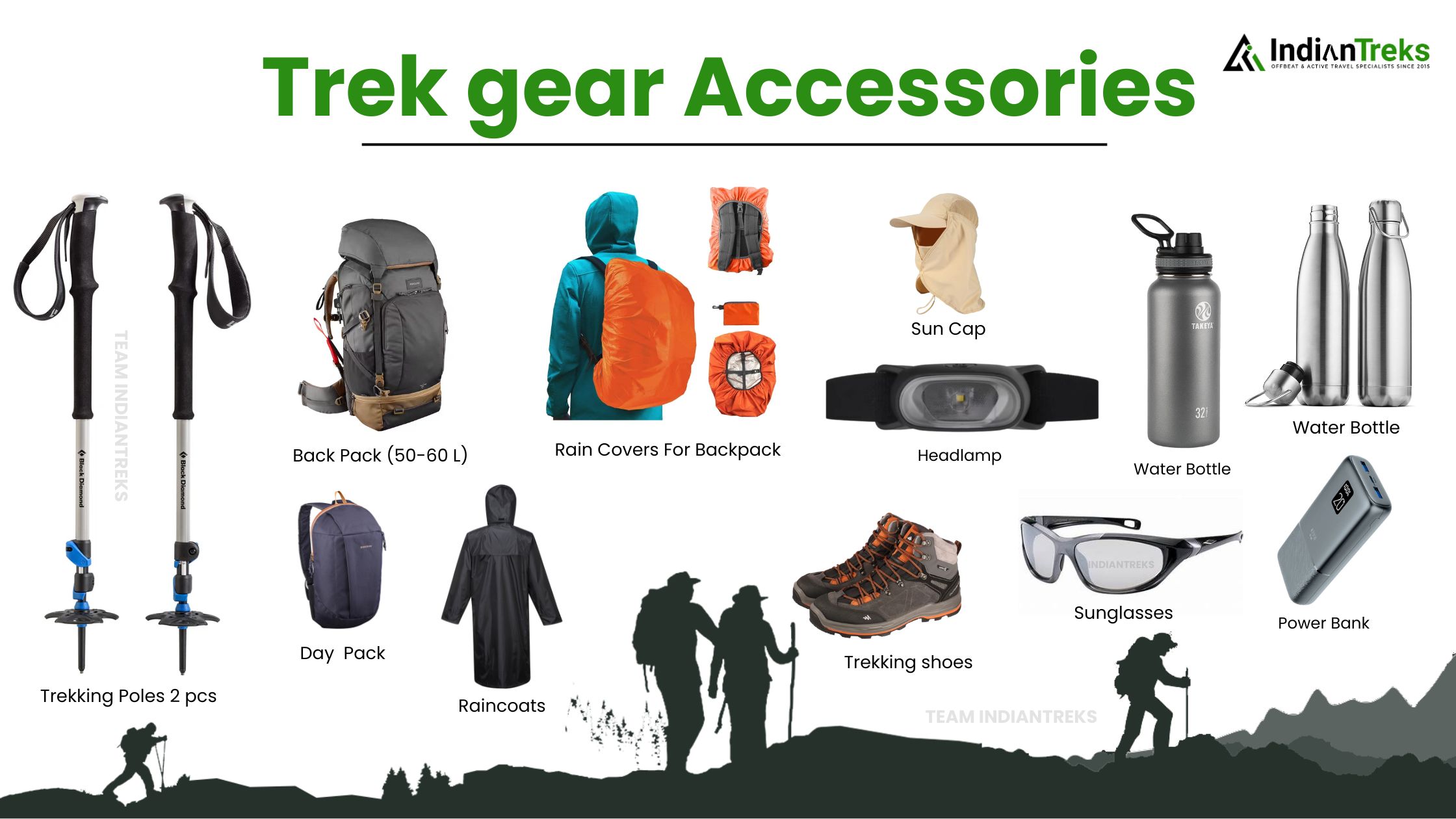

Clothing Guide for High-Altitude Trekking
Mountains have unpredictable weather, so dressing in layers is crucial. Here’s a breakdown of layering based on the season:
Spring, Summer & Monsoon Treks: 3 layers – a woolen sweater, a fleece, and a padded jacket.
Autumn Treks: 4 layers – a woolen sweater, two fleeces, and a padded jacket.
Winter Treks: 5 layers – thermals, a woolen sweater, two fleeces, and a padded jacket.
Upper Body
T-Shirts/Sleeve Shirts – Bring three T-shirts and two quick-dry trek pants, wearing one and carrying the others. Long-sleeve shirts help protect from UV rays. Synthetic T-shirts are recommended as they dry quickly when wet.
Hiking/Trekking Jacket – A down jacket (-5°C to -10°C) or a high-quality two- to three-layer jacket.
Thermals – At least two pairs to maintain body warmth in cold weather.
Lower Body
Trek Pants – Bring 2-3 comfortable trekking pants. Trekking pants are essential for comfort and mobility. They should be synthetic for quick drying when wet.
Undergarments – Pack according to personal hygiene and comfort needs.
Accessories
Gloves – 1 pair of gloves to keep your hands warm.
Rain Wear – Choose between a raincoat or a poncho.
Raincoat: Effective for light rain but may leak during prolonged downpours.
Poncho: Offers full-body coverage, including your backpack, keeping both you and your gear dry.
Tip: If using a raincoat, carry a small waterproof cover for your backpack to keep your belongings dry. If you opt for a poncho, it will naturally protect both you and your backpack.
Get ready for the Kedarkantha trek with the right gear! From thermal wear and sturdy trekking boots to personal hygiene essentials, this guide ensures you stay warm, comfortable, and prepared for the snowy trails ahead.Hygiene & Personal Toiletry Essentials
Quick-drying towel – Compact and lightweight.
Toilet paper/wet wipes (biodegradable) – Essential for hygiene.
Hand sanitizer – Keeps hands germ-free.
Toothbrush & toothpaste tablets – Space-saving oral care.
Mouth freshener/mint strips – Keeps breath fresh.
Deodorant/talcum powder – Controls odor and sweat.
Dry shampoo/shampoo sheets – Hair care without water.
Lip balm (SPF) – Prevents chapped lips.
Biodegradable soap & body wipes – Eco-friendly hygiene.
Foot powder – Prevents sweat and infections.
Nail clipper & tweezers – Grooming essentials.
Mosquito repellent – Protects from insect bites.
Anti-chafing cream – Prevents skin irritation.
Menstrual cup/sanitary pads – For female trekkers.
Cooling eye drops – Refreshes tired eyes.
Compact mirror – Useful for grooming & emergencies.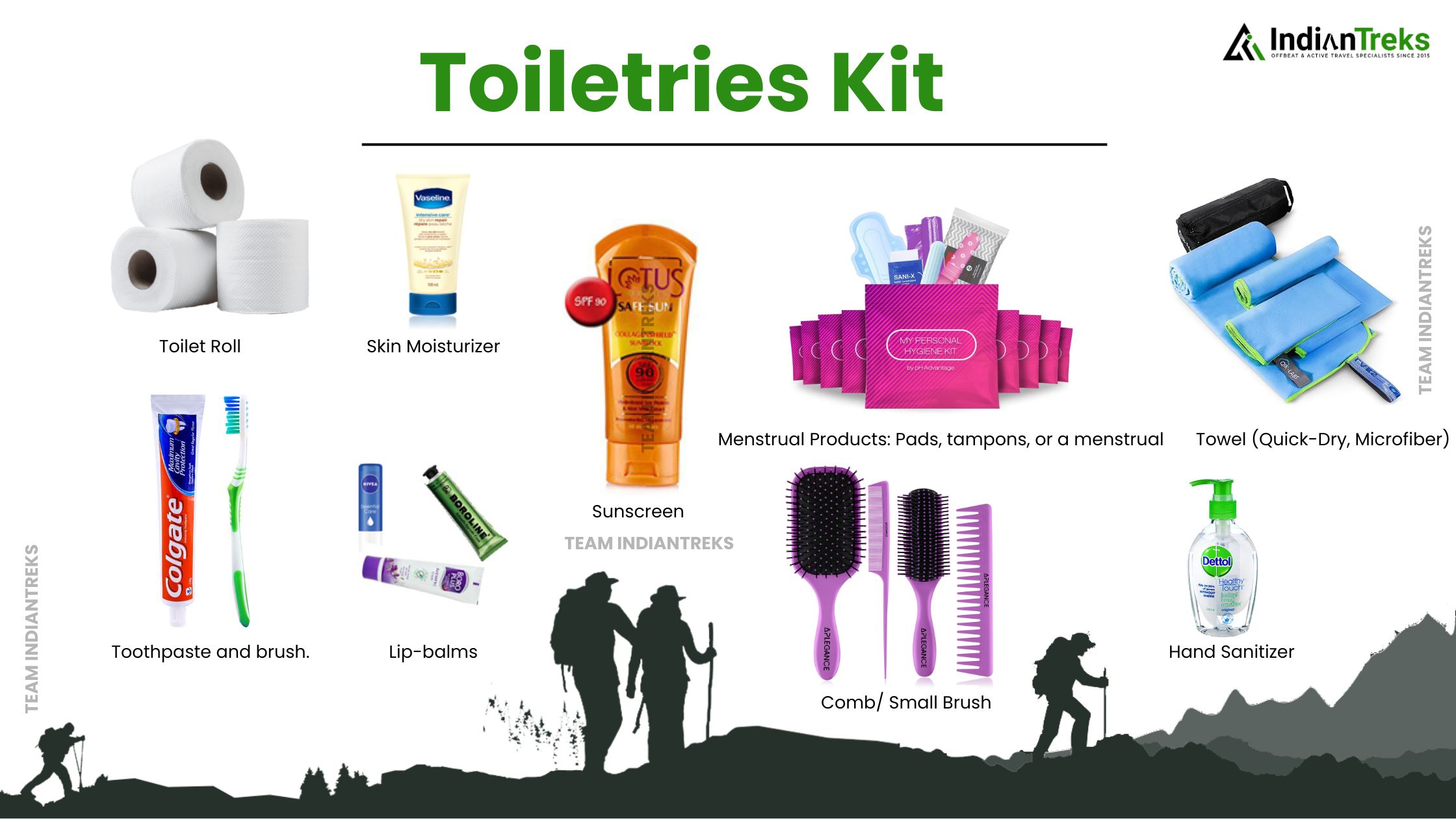
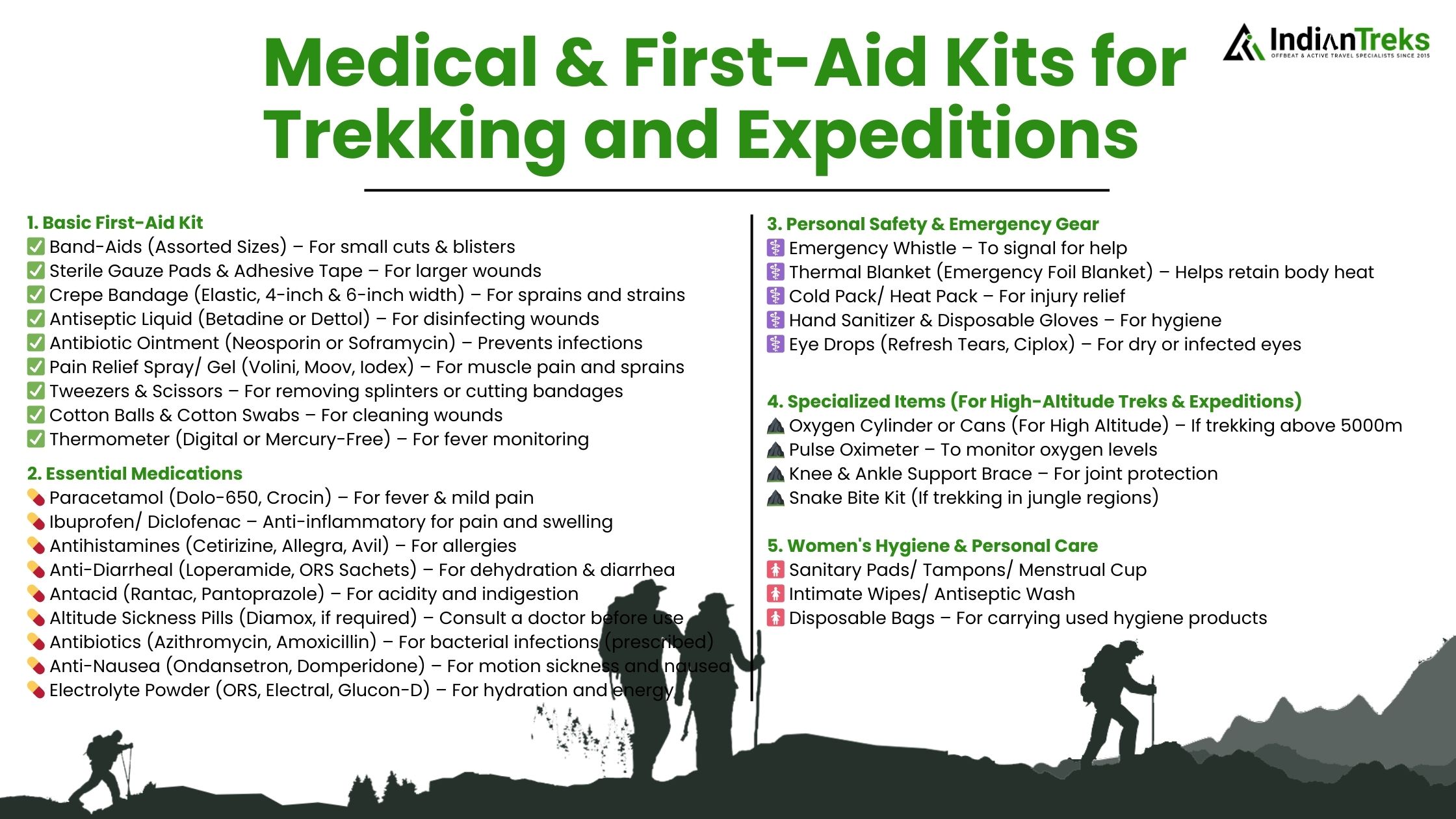
Personal First Aid Kit
Butterfly bandages: For small cuts
Cotton, elastic bandages, and sterile gauze pads: For larger wounds
Latex gloves: Essential for handling bleeding wounds
Medicine for diarrhea (upset stomach)
Medicine for cold, flu/fever, and headache
Painkillers
ORS pouches: To prevent dehydration
Quick pain relief spray (for external use)
Any personal medication prescribed by your doctor
Diamox or similar medication for high altitude sickness
Bug repellent
Energy bars and non-alcoholic energy drinksEssential Documents You Must Carry for Your Trek
These must be submitted to the Forest Department before your trek begins:
Original & Photocopy of a Government-Issued Photo ID (Any one of the following)
Aadhaar Card
Voter ID
Driving License
Passport (for foreign nationals
Trekking Permit (If applicable, issued by the local forest department or tourism board)
Medical Fitness Certificate (Recommended, especially for high-altitude treks)
2. Recommended Documents for Safety & Convenience
Emergency Contact Information – A printed copy with names and numbers of family/friends.
Insurance Details – Travel or trek insurance (if applicable) for medical and evacuation purposes.
➩ Why choose us for Kedarkantha Trek
Choosing a suitable trekking company can make significant effects on your Himalaya trekking experience. In the trekking community, Indian Treks is an established company recognized for its professionalism, high standards for safety, and excellent quality of service. For the Kedarkantha Trek Package Indian Treks is the best choice for the following reasons:
Trek Leaders & Certified and Experience
Our team is made up of qualified trek leaders and experienced mountaineers who are well-versed in the Himalayan landscape, climate, and safety at high altitudes.
Smaller Group Size for Better Experience
We believe that small, well-run groups provide personalized attention, a better trekking experience, and less of an impact on the environment.
Campsites that are comfortable and hygienic
For your comfort, we provide well-maintained campsites in scenic location, warm sleeping bags, and spacious waterproof tents.
Delicious and Nutritious Food
We serve hygienic fresh, and energizing vegetarian meals that will keep you going. Special dietary requirements? We'll take care of you!
All-Inclusive and Transparent Pricing
No hidden costs! Our trek package ensures a hassle-free experience by including permits, a meal, from Dehradun, trek equipment, and expert guides.
Our top priority is safety.
Always keep first aid kits and oxygen cylinders on available.
Trek leaders completed emergency wilderness first aid training.
strict safety protocols to ensure a trek free of risk.
Sustainable and Eco-Friendly Trekking
Our Leave No Trace policy ensuring that impact on the environment is kept to a minimal. Through maintaining clean trails while supporting community members, we promote ecotourism.
High-quality trekking gear is provided.
Don't worry about the equipment! For trekking in snowy conditions, we provide premium sleeping bags, gaiters, and crampons.
Dates of Departure: Fixed and Flexible
We offer flexible options for adjusting your schedule along with confirmed departures, allowing you to easily organize your trek.
Plan Your Adventure with Us!
As a trusted local tour operator in Sankri, we are committed to making your Himalayan adventure memorable, safe, and enriching. Whether you’re looking for a thrilling trek, a peaceful getaway, or a cultural experience, We have a perfect Kedarkantha trek itinerary for you.
Book with confidence!
Indian Treks ensures the best trekking experience possible with first-rate amenities, safety, and knowledgeable guidance. Kedarkantha Trek with us and have an unforgettable Himalayas experience.
Sankari Village, nestled in the heart of the Garhwal Himalayas, offers as the perfect base for some of Uttarakhand's most adventurous and spectacular treks. As a Sankari-based tour operator, we take great satisfaction in providing authentic, safe, and well-curated trekking experiences for adventurers, nature lovers, and explorers of all backgrounds. Our intimate connection to the land, culture, and communities guarantees that every journey with us is more than just a trek, but an amazing adventure filled with tradition and genuine hospitality.
While some journeys are about the destination, others are about the transformation they bring about. The Kedarkantha Trek Uttarakhand is both. Every step of this trek into the purest form of nature offers a story of adventure, peace, and discovery; it's more than just a route meandering through the Himalayas.
A Walk Through an Untouched Paradise
Nestled in in the heart of Uttarakhand, Kedarkantha is a place where time seems to stand still and the mountains envelop you in their quiet majesty. A world of tall pines, icy meadows, and snow-covered peaks opens out before you as soon as you enter the trail. Your lungs are filled with the clean mountain air that smells of cedar and deodar, reawakening a deep connection to the natural world. With crystal-clear streams reflecting the sky, bright rays piercing the thick forest, and expansive views of the majestic Himalayan peaks standing like everlasting sentinels, every turn in the trail offers a fresh scene. However, Kedarkantha's charm extends beyond its natural surroundings. The gentle crunch of snow under your boots and the whispering winds are two examples of the silent symphony of the wild.
The Summit: More Than Just a Peak
At 12,500 feet, trekking to the Peak Of Kedarkantha becomes more than just a physical test; it becomes an adventure of self-discovery. A profound sense of achievement overtakes you as the snow-covered peak is embraced by the first rays of sunrise, transforming it into a golden view. Infinite horizons reveal a stunning 360-degree panorama of the legendary peaks of Ranglana, Bandarpoonch, Black Peak, and Swagarohini. It dawns on you then that you have overcome not just the mountain but also your own doubts, borders, and limits.
A Night Under a Starlit Symphony
But the little things—the warmth of a crackling bonfire, the laughter of fellow trekkers, and the hot cup of chai that tastes like pure ecstasy in the chilly mountain air—are what really make the Kedarkantha experience. The Milky Way spreads over the skies in all its splendor when night falls, and the sky becomes a celestial canvas with stars that gleam like strewn diamonds. It serves as a reminder of both our insignificance in the vast scheme of things and our profound sense of connection to it.
Best Time for the Kedarkantha Trek
The best time to set out on this incredible adventure is between December and April, when the sky are still clear, the woodlands are shrouded in a mysterious white mantle, and the route is covered in pure snow. Kedarkantha is one of the most popular Himalayan treks because of its winter attractiveness, which provides the ideal balance of challenge, beauty, and seclusion.
The Kedarkantha Trek in Uttarakhand is a nature lover's dream, with breathtaking views and a broad range of wildlife. As the route travels through the Govind Wildlife Sanctuary, trekkers may see a variety of Himalayan flora and animals. If you're lucky, you could see Himalayan monals, musk deer, wild boars, and perhaps the rare snow leopard. The area is also home to bright butterflies, mountain foxes, and a variety of high-altitude bird species, making it an ideal trip for wildlife aficionados. The terrain varies regularly, from deep pine and oak woods to broad meadows, offering breathtaking views at every turn. During April, the route comes alive with flowering rhododendrons, providing splashes of color.
One of the best Himalaya trek for beginners is the Kedarkantha Trek, which provides the ideal balance of accessibility, excitement, and natural beauty. This trek, which is in Uttarakhand, is renowned for its gratifying summit experience, moderate difficulty, and clearly designated paths. It's a great option for beginners trekkers for the following reasons:
Moderately to Easy Difficulty Level
With well-marked pathways and gentle ascents, the trek is not too strenuous. It's manageable for beginner trekkers with basic levels of fitness. It is possible to reach the highest 12,500 feet (3,810 meters), with the right acclimatization.
Short Duration & Well-Paced Itinerary
Kedarkantha Trek is typically a 4-6 day trek, making it perfect for beginners who want to experience Himalayan trekking without long commitments. The daily trekking distance is around 4-6 km, which is comfortable for most people.
Year-Round Trek, Best in Winter
While Kedarkantha is accessible throughout the year, it is especially popular in winter (December to March) for its snow-covered landscapes. Beginners get to experience a winter trek without extreme difficulty
Stunning Views with Minimal Effort
The summit of Kedarkantha offers 360-degree panoramic views of major peaks like Swargarohini, Black Peak, Bandarpoonch, and more. Unlike other treks that require multiple days to see such scenery, Kedarkantha delivers these views within a few days of trekking.
Beautiful Campsites & Forest Trails
The trek passes through dense pine and oak forests, clearings with open meadows, and frozen lakes, making the journey visually stunning. Campsites like Juda Ka Talab and Kedarkantha Base Camp offer serene beauty, perfect for first-time trekkers
Well-Established Trail with Good Support
Since it is a popular trek, there are experienced guides, porters, and trek operators available. First-time trekkers can feel secure with professional support, ensuring a safe and enjoyable experience.
Great Introduction to High-Altitude Trekking
Kedarkantha is a stepping stone to more challenging treks. It introduces beginners to high-altitude conditions, snow trekking, and camping in the wilderness, preparing them for future Himalayan adventures
Sankri, a picturesque village in Uttarakhand, serves as the base camp for the famous Kedarkantha Trek. Nestled in the Govind Wildlife Sanctuary at an altitude of 1,950 meters, Sankri is not just a stopover but an experience in itself. With its scenic beauty, rustic charm, and warm hospitality, it welcomes trekkers embarking on one of the most popular winter treks in India.
Reaching Sankri
Sankri is approximately 200 km from Dehradun, the capital of Uttarakhand. The journey takes around 8-10 hours by road and passes through stunning landscapes, including lush forests, meandering rivers, and quaint mountain villages. Private taxis and state-run buses operate between Dehradun and Sankri, making it accessible for trekkers and travelers
Sankri accommodation
Sankri has a variety of accommodation including comfortable guesthouses to affordable homestays. Warm, comfortable accommodations with traditional timber décor are offered by a number of local homestay. With delicious Pahadi meals like rajma-chawal, aloo ke gutke, and regional teas, visitors may experience the local way of life and food while staying in Sankri.
Exploring Sankri
Sankri offers a number of sites worth seeing, even though it is mostly used as a base camp for the Kedarkantha trek:
Sunset Point: Provides captivating views of Bandarpoonch and Swargarohini peaks.
About 12 kilometers from Sankri, Taluka Village is a charming hamlet distinguished by its traditional wooden homes and calm atmosphere.
Local Market: A little marketplace where one may purchase organic honey, handicrafts made locally, and trekking gear.
One of the most popular winter treks in the Indian Himalayas is the Kedarkantha Trek, which is renowned for its amazing summit views, enthralling scenery, and gorgeous snow-covered paths. Juda Ka Talab, a calm and mystical high-altitude lake that enchants every trekkers heart, is one of the trek's many highlights.
At 2,700 meters (8,858 ft) above sea level, Juda Ka Talab is a small yet charming lake. This lake, which is surrounded by thick pine and oak forests, is significant both mythologically and as a key site for camping on the Kedarkantha trek.
According to local folklore, the lake was formed when a droplet of water fell from Lord Shiva’s hair, giving it the name “Juda” (meaning “connected” or “linked”). This adds to the spiritual aura of the place, making it an ideal spot for reflection and relaxation amidst nature
Why Juda Ka Talab is a Must-Visit
Scenic Beauty – The lake is frozen during winters, transforming it into a mesmerizing icy wonderland. In summer, it reflects the surrounding pine trees, offering a completely different yet equally breathtaking view.
Perfect Camping Spot – Juda Ka Talab serves as an ideal campsite for trekkers on their way to Kedarkantha summit. The lush meadows around the lake provide a peaceful and scenic camping experience.
Wildlife and Nature – The region is rich in biodiversity. Trekkers can spot rare birds, Himalayan langurs, and even the occasional fox.
Kedarkantha Base Camp A Stunning Halt on the Kedarkantha Trek
Among India's most popular winter treks, the Kedarkantha Trek offers stunning vistas, thick pine woods, and an enthralling summit experience. Kedarkantha Base Camp, an essential stopover before the last climb to the peak, is one of the trek's main attractions. The beauty, importance, and camping experience of Kedarkantha Base Camp are examined in this essay.
Key Highlights of Kedarkantha Base Camp
Scenic Beauty: The base camp, which is situated at an elevation of around 11,200 feet (3,414 meters), provides breathtaking sweeping views of the surrounding Himalayan peaks, such as Swargarohini, Bandarpoonch, and Black Peak.
Views of the Sunrise and Sunset: The base camp is well-known for its breathtaking views of the sunrise and sunset. A picture-perfect scene is created by the golden hues reflected off the snow-covered summits.
Stargazing & Night Camping: Kedarkantha Base Camp is a great place to observe the stars because there is no light pollution. A starry sky is a common sight for campers, which makes the experience truly remarkable.
Acclimatization & Preparation: Before the strenuous final climb to Kedarkantha Summit (12,500 feet / 3,810 meters), trekkers can relax and acclimate at this halt.
Camping Experience at Kedarkantha Base Camp
Among India's most popular winter treks, the Kedarkantha Trek offers stunning vistas, thick pine woods, and an enthralling summit experience. Kedarkantha Base Camp, an essential stopover before the last climb to the peak, is one of the trek's main attractions. The beauty, importance, and camping experience of Kedarkantha Base Camp are examined in this essay.
Nestled within the Govind Wildlife Sanctuary in Uttarakhand, Kedarkantha is a breathtaking journey that is perfect for beginner Himalayan trekkers. What is too young in terms of age, though? What is the age at which something is too old? Our belief at Indian Treks is that fitness, not age, is the deciding factor.
Ideal Age Range for the Kedarkantha Trek
We recommend the trek for those between 6 years to 60 years. However, the ability to complete it depends on stamina, endurance, and mental preparation. While children and seniors can participate, they should be well-prepared and take necessary precautions.
6-12 Years: Young Adventurers
Children can enjoy this trek if they are physically active and accustomed to outdoor activities. A child who enjoys long walks, is comfortable in colder temperatures, and has previous trekking experience will have an easier time.
Key Considerations:
Must be accompanied by a responsible adult (parent/guardian).
Should practice short trek before attempting Kedarkantha.
Ensure they have proper winter gear (if trekking in snow).
13-50 Years: Peak Trekking Age
This is the ideal age group for the trek. If you have a basic level of fitness, you will thrive on this journey. The trek is moderate in difficulty, with some steep climbs and long walking hours.
Key Considerations:
Endurance training (walking, jogging, or stair climbing) will enhance the experience.
If you are new to trekking, start training at least a month in advance.
Carry a well-packed backpack but avoid unnecessary weight.
51-60 Years: Senior Trekkers
Trekkers over 50 can successfully complete Kedarkantha if they stay fit and take it slow. Age is not a limitation, but underlying health conditions can be.
Key Considerations:
Medical clearance is recommended, especially for those with heart, lung, or knee issues.
Acclimatization is key—trek at a slow pace and take enough rest.
Use trekking poles for better balance and knee support.
Consider hiring a porter or mule if carrying a backpack is challenging.
Important Factors for All Age Groups
Family & Group Trekking: A Perfect Adventure!
Kedarkantha is one of the best Himalayan treks for families, friends, and beginners. Many parents bring their kids, and many senior trekkers join as a bucket-list adventure. Trekking in a group adds fun, motivation, and safety.
Medical Considerations for Older Trekkers
If you have conditions like hypertension, asthma, or joint pain, consult a doctor before the trek. Carry necessary medications and inform your trek leader about any health concern
Seasonal Suitability: Winter vs. Summer
Winter Trek (December–March): Snow-covered landscapes, frozen lakes, and magical scenery—but cold temperatures require better endurance.
Summer Trek (April–June): Green meadows, blooming rhododendrons, and milder temperatures—ideal for first-time trekkers.
₹ 5,499/PP
5D - 4N | Dehradun to Dehradun
- Pickup Time : 7:30 To 8:00Am
- Dropping Time : 7:30 To 8:00Pm
- Pickup & Drop Location : Dehradun Railway Station
Need Help Talk to our Mountain Expert
- +91- 7310954451 | +91-7300900108
BE UPDATED FOR THRILLING EXPERIENCES!
Follow Us On
Ask Your Query Here !!
BE UPDATED FOR THRILLING EXPERIENCES!
Follow Us On
➩ Trekker Stories And Experiences With Indiantreks
It was a wonderful adventure, and Indian Treks offered excellent service. The staff members had a wealth of expertise and understanding, such as how to manage large groups and ensure the safety of individual trekkers.

